
Spring 2024
Kelly Geary ’93
Vision & Verve [COVER STORY]
Finding a North Star Todd Rogers ’83
Guiding Change Christi Lilly Durham ’92 & Gary Powers ’71
Igniting Innovation Del Smith ’01
THE LABORA MAGAZINE
Labora is a publication of the Benedictine Schools of Richmond, a unified organization of Benedictine College Preparatory and Saint Gertrude High School, focusing on entrepreneurship, innovation, and the evolving world of business.
Spring 2024

FEATURE | 4
Perpetual Motion
Kelly Geary ’93 is entrepreneurial energy personified.
FEATURE | 16
Finding a North Star
Todd Rogers ’83 leads the way in suburban residential development.
 JOURNAL OF ENTREP RENEURSHIP
JOURNAL OF ENTREP RENEURSHIP

FEATURE | 28
Guiding Change
Christi Lilly Durham ’92 and Gary Powers ’71 support young people in foster care.


. EDUCATION | 44
Igniting Innovation
BSoR launches entrepreneurial studies program.

• • • LABORA 1
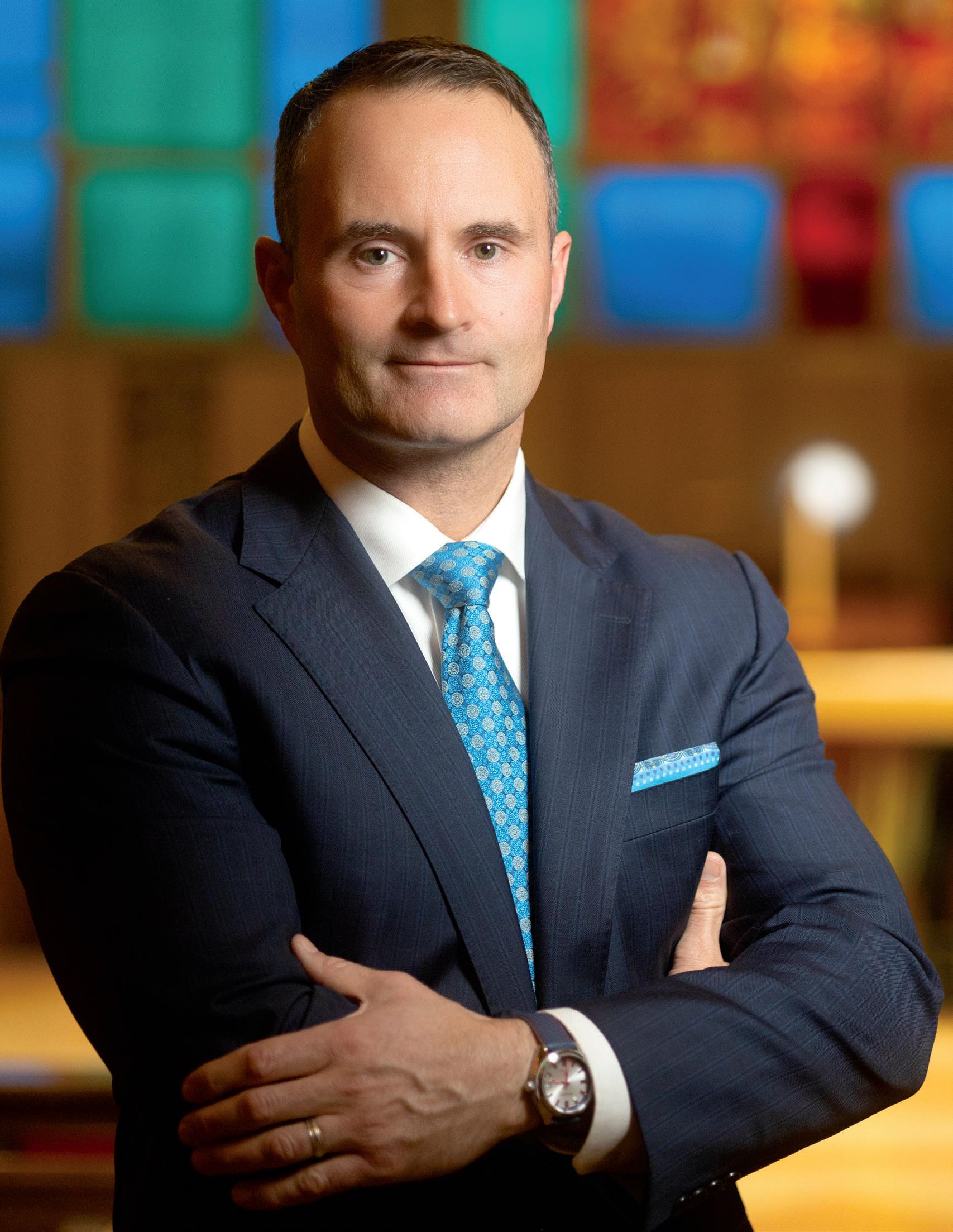
2 LABORA • • •
— WELCOME —
Benedictine and Saint Gertrude Family,
They offered me the “Distribution Manager” position at their west coast fulfillment center in Reno, Nevada. It was 2005. The company’s name was Amazon.
However, there was another company at the job fair I was attending. It was a private school in the San Francisco Bay Area. Its representatives at the fair had no interest in my resume or in me, whatsoever. After all attempts at persuasion had failed, I made my final and best offer to the school system’s HR manager — I would work for free. She laughed in my face. “Yes,” I confirmed to her (without my wife’s consultation, not a great idea), “I will come to work for you for free for one month to get my foot in the door at your school. If it doesn’t go well, you can fire me, and what will you have lost?” At first incredulous, she saw that I was serious and, still laughing, said, “Ok, I’ll get you an interview. The rest is on you.”
Sometimes I look back on that hiring fair and think to myself, “Hmmm, you’re a real idiot. You could’ve been in on the ground floor of Amazon. That would’ve been good.” Then I think about all the kids that we’ve helped at Benedictine and Saint Gertrude. I think about all the cool, creative stuff that we’ve been able to build on our campus and I realize that, although there was a lot of juice at Amazon, there wasn’t a lot of spiritual fruit. I was able to be creative, just where God wanted me to be.
Reflecting on the merits of that choice also makes me so proud that, among the stories we share in this fourth issue of LABORA, we feature alumni from Benedictine and Saint Gertrude who are using their entrepreneurial talents in the non-profit space to make the world a better place for some young people who desperately need it. Christi Lilly Durham ’92, Gary Powers ’71 and Don DeLaney ’71 are truly changing people’s lives through their entrepreneurial endeavors. I hope that, through their stories, you will find inspiration to apply your own creativity to help someone in need of your support.
Yours in Prayer and Work,
JESSE GRAPES PRESIDENT, BENEDICTINE SCHOOLS OF RICHMOND
— LETTER FROM THE PRESIDENT — • • • LABORA 3
PERPETUAL


4 LABORA • • •

MOTION is Entrepreneurial Energy Personified

Kelly Geary notes that her father — Bob, a baseball fanatic who taught his daughter how to score a ballgame before she fully learned to write — is fond of quoting Joaquín Andújar, a standout Major League pitcher from the 1980s. The quote: “You never know.” Explains Geary, “It’s a powerful concept. You don’t know what is ahead. Things change, so you can’t hold on too tight to certainty.”
Indeed, Geary’s career is chock full of twists and turns. She has worn enough hats to fill a Kentucky Derby grandstand: journalist, theater muse, business startup sparkplug, recruiting ace, altruistic innovator. The list is extensive, and Geary has enthusiastically embraced where each pivot has landed her.
One thing that has held its place as a common denominator is easy to identify: “Energy, energy, energy,” declared Craig DeDomenico, vice president of the UVA Benefactors Board for the College Foundation, of which Geary serves as president. “Kelly brings consistent positive energy. She is a force of nature who uniquely creates that presence while remaining well-liked by all.”
Older people will tell you that as they reflect upon the lives they have led, they do not regret their failures. Rather, they regret those things they failed to try.
Someday, when she is old, Kelly Geary will have no regrets.
The still-young Geary, Saint Gertrude Class of ’93, has thus far led a life of entrepreneurial spirit, relishing new adventures and tackling business challenges with a vigor that is matched only by
her joie de vivre. Indeed, Geary’s is the poster page for LinkedIn impressiveness, with an array of roles and experiences founding some knock-your-socks-off start-ups.
She is currently focusing nearly all her entrepreneurial energy toward altruistic enterprises, the latest stop on what has been a wild ride.
Geary incorporates all the life lessons she has picked up into her ongoing and upcoming ventures. For example, shortly after graduating from the University of Virginia, she briefly dabbled with the goal of becoming a high school teacher. She got a good taste of the profession when she worked as a student teacher in an Austin-area high school. While she realized her calling was elsewhere, today she still applies concepts and approaches she developed during that one-year stint.
FROM CHARLOTTESVILLE TO THE BIG APPLE
At the University of Virginia, Geary’s extracurricular focus lasered on two areas — journalism and theater. As a member of The Cavalier Daily staff, Geary reported and penned op-ed pieces. Her main love, however, fell upon the stage, as she served as a dramaturge (one who provides research and interpretation about the theatrical work to the cast and crew) for the student drama set. Her experience in that world prompted her to move, upon graduation, to New York City in pursuit of making it big on the Great White Way. “New York is a magical place,” Geary said. “I wanted to be able to say, ‘I did that.’ But it was insanity, and I was hustling just to be able to make the money to stay there.”
• • • LABORA 5
“Kelly’s always been an ‘out of the box’ and highly collaborative person from the moment that I met her...”
Talk about scrappy. Geary took a job as an au pair for a woman she met on her flight into LaGuardia. Her concurrent hunt led to working in the entertainment field as she landed a position with the newly launched FX channel. On the one hand, it was everything a recent college graduate — single, footloose, and living in the heart of Manhattan while working in her dream field — could hope for. Unfortunately, the stars fell from her eyes when she realized “the entertainment industry is mostly about revenue and ratings. It’s so sad. TV is wild, but you make no money, at least not in the backstage operations area.”
Such sadness (and destitution) was short lived, as Geary then earned a spot with Citibank, working in human resources while specializing in global reporting. It was there that she found her true calling, as that role gave her a good taste of what went into personnel recruiting, as well as its organizational importance.
LOOKING WESTWARD
Meanwhile, Geary’s innate wanderlust came calling once more. “I wanted to go to the West Coast,” she recalled. “Specifically, I wanted to be in San Francisco.” She made it only half the way there. Instead of heading due west, Geary followed a more southerly azimuth, stopping in Austin, Texas. She landed in the yet-to-boom (with 900,000 residents vs. 2 million today) Lone Star capital instead of the City by the Bay due to a serendipitous job offer that had her working in managerial recruiting with a later focus on executive positions.
Despite finding success in placing C-suite executives, Geary felt a different pull — toward being her own boss.
She knew she had found a personal niche in matching company needs with available talented people, so she leveraged that skill in a pair of start-ups that she created: HireBetter and PeopleGetters, both of which were born in the heart of entrepreneurial Texas. (Austin is often called the “Silicon Hills” and is noted for its high
There’s No Place Like Home
A PIONEER IN WHAT WOULD BECOME COMMONPLACE: REMOTE WORK
“I was country when country wasn’t cool.”
Barbara Mandrell’s smash 1981 song alluded to the singer’s involvement with country music long before it began its encroachment into crossover status and appearance on pop charts.
We share this bit of musical lore because of Mandrell’s parallel with that of Kelly Geary, who pioneered the idea of executive-level work from home long before it became cool.
Of course, the onset of COVID-19 was the most significant driver in having millions of white-collar workers converting their bedrooms into home offices. Today, more than three years after the onset of the crisis, scads of workers continue to work from home, and the media is chock-full of stories of employees and employers making these arrangements permanent.
“I have always worked from home,” asserted Geary. In fact, she’s done more than that. Geary founded two companies, HireBetter and PeopleGetters, that had working-from-home as their foundational staffing models. Using her own experience as a gauge, Geary could set conventional thinking aside in that she knew how productive workers could be from their homes. The idea of working from home was less than revolutionary. Geary’s big innovation was having an entire company operate in such a fashion.
IBM is considered one of the pioneers of remote work, implementing such a scheme in the 1980s that included a large group of employees from its massive workforce. Most of that work was done as employees connected via “dumb terminals” to mainframe applications.
By the turn of the century, collaborative software, Voice Over Internet Protocol (such as Skype) and mobile telecom (really, starting with the introduction of the Blackberry) paved the way for a major enablement of the mobile workforce.
A NEW WAY TO THINK ABOUT WORK
In most cases, however, businesses were doing the “same-old, same-old,” but just having it done somewhere other than at the home office — some might call it “paving the cart path.” Geary’s innovation was to capitalize on the enabling technologies
MEG MARSH CHIEF PEOPLE OFFICER, ARGO DESIGN
6 LABORA • • •
population of “Dell-ionaires,” those who made their fortunes with computer innovator Michael Dell.) “It really is an ecosystem of entrepreneurship,” said Geary of the town. “It has a wildly smart pool of people.”
THE ENTREPRENEURIAL BUG
If you want a story about a company founded in a kitchen, HireBetter’s tale is for you. Pregnant with her first child, in 2005, and concurrently recruiting for Acadia (her first Austin gig), Geary decided that was a good time to strike out on her own. “I started a teeny consulting business — just me,” she recalled.
Soon, the opportunities piled upon themselves. Realizing she needed help and knowing she possessed world-class recruiting skills, Geary turned toward her neighbor, Abby Sandlin. “I trained her in one week, and she was my first hire.”
That hire opened the spigot to what would become HireBetter, with 40 employees from coast to coast. Geary’s business model was simple: hire stay-at-home parents who would work somewhere south of 20 hours per week. “Most were pros with recruiting experience who were downshifting to have and raise children,” she recalled. “We broke recruiting into silos.”
to activate what would otherwise be a talented, but dormant, workforce — capable professionals with a strong motivation to work from home — in many cases, parents of young children. In the early 2000s, working parents either took a hiatus from the job or found an alternative means (such as daycare) to watch their children.
“Neither of us wanted to raise kids while working 9-to-5 in a traditional setting,” said Abby Sandlin, Geary’s first employee at HireBetter. “Based on Kelly’s inspiration to break the mold, I reframed what a ‘job’ meant and how I could apply my skills and experience in a talent-driven manner instead of hierarchical expectations.” (Today, Sandlin serves as chief development officer for the United Way for Greater Austin.)
In 2005, when Geary founded HireBetter, the ideas of freelancing and working-from-home were barely blips on the macro-business
Indeed, HireBetter had professionals filling roles such as researchers (headhunter), converters (convincers) and interviewers, with each employee type passing along candidates down the line. Employees were free to make their own hours, as long as the agreed-to work was completed and was done so successfully. “We went after people,” Geary enthused.
Unlike most recruiting agencies, which create a partnership between candidate and recruiter, Geary’s innovation allowed for focused expertise along each step of the process. It also provided flexibility, so that parents could provide attention to their families when it was most needed.
Working the demand side of recruiting, HireBetter was netting a 55 percent per-hour yield (before other expenses), so her venture was doing quite nicely. Yet, family comes first, and Geary was juggling a number of items in that category. She sold the company in 2011, and HireBetter remains a force in the world of recruitment, today offering services such as strategic talent planning, permanent positioning, project consulting and turn-key staffing solutions.
radar. Freelancing was something that musicians did, and Amway salespeople were the type who worked from home. Technology and a cultural shift changed all of that. Geary just happened to see it coming.
Both HireBetter and PeopleGetters were all about innovation and flexibility. Both of these start-ups used an approach that had all employees working from home. That model gave the workers the opportunity to decide when they would tend to their obligations, oftentimes when the wee ones were fast asleep. “I wasn’t concerned with when they did their work, as long as it got done,” recalled Geary.
That flexibility extended to Geary, herself. She could as easily run her companies from the comfort of her home as from an airport lounge (or, for that matter, a traditional office). Thus, when she moved from Austin to the Phoenix area, she missed not a beat. “It is because I
“Based on Kelly’s inspiration to break the mold, I reframed what a ‘job’ meant and how I could apply my skills and experience in a talent-driven manner instead of hierarchical expectations.”
was both an entrepreneur and intentionally built my business as a 100 percent workfrom-home model that I had the freedom and flexibility to make the relocation happen,” she stated.
Many of today’s workers demand flexibility as a matter of course. Terms such as collaborative software, Zoom, remote worker, hybrid workforce and Google Meet are standard in business-speak. As is “working from home.”
But that term has always been a big part of Geary’s vocabulary.
— PERPETUAL MOTION — • • • LABORA 7
ABBY SANDLIN, CHIEF DEVELOPMENT OFFICER, UNITED WAY FOR GREATER AUSTIN

BACK AT IT
After a year, Geary was ready to re-join the fray. “I like what Winston Churchill says,” stated Geary. ‘“If you’re going through Hell, keep going.’ Life is not designed to be easy; you can’t get around it.”
In 2012, a favor Geary did for her next-door neighbor morphed into her becoming executive vice president of people at Headspring, a leading software development and consulting firm in the Austin area. Geary found herself in conversation with that next-door neighbor, who was wrestling with a recruiting issue.
She shared that she could help. “That one problem solved turned into a regular recruiting consulting gig, which morphed into a very real position.”
That company was better off for the hire. “Kelly came to Headspring and shook up the entire People team by bringing vision to the department: HR, culture, and recruiting,” noted Ashish Patel, founder and CEO. “Headspring had a very high bar on who we let in. Kelly was able to meet this bar while still scaling the recruiting team’s ability to hire to meet the demand.”
Geary states that she loved Headspring. Indeed, the company is consistently listed as a “best place to work” by the Austin Business Journal and Texas Monthly magazine. She was tasked with making all of Headspring’s people-related functions both scalable and long-term. While Geary loved the work, she felt the entrepreneurial bug’s siren song calling once again.
Thus was born PeopleGetters, which Geary founded in the summer of 2014, a period she calls “the best time of my life.”
She kept it simple with PeopleGetters, a marked differentiation from her time at HireBetter. “It was just me and a bunch of contractors,” she recalled, also noting that she focused on wellestablished clients in supplying them with top-quality specialists (such as supply chain and ERP). “It was in-and-out work,” she noted.
Geary gets ready for the 2020 ISSA Summer Olympics where, as people leader, she served as one of two judges.
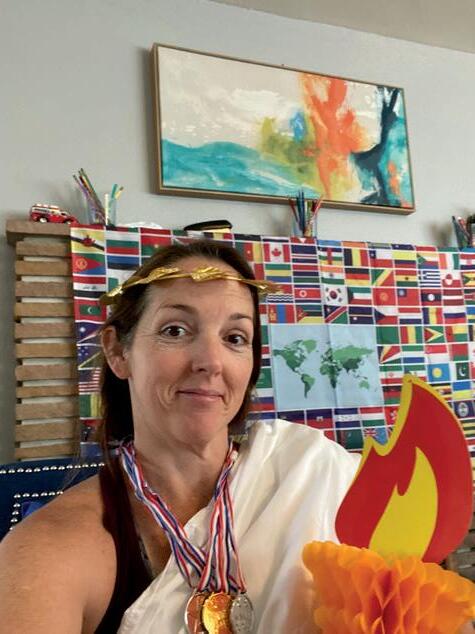
Meg Marsh, currently the Chief People Officer at Argo Design, was with Geary during PeopleGetters’ early days. “Kelly’s always been an ‘out of the box’ and highly collaborative person from the moment that I met her,” Marsh said. “Not only did she find a way to build and scale her own business … but she has an infectious positive attitude that makes her someone with whom everyone wants to work and just be around.”
Geary had the company’s focus squarely aimed on three simple terms — connect, respect and value — and that is still where it resides. Additionally, as with HireBetter, she baked flexibility into the recipe. Part-time, highly qualified recruiters and human resources experts staffed her roles, with all work done from the location of one’s choice.
PHOENIX RISING
That flexibility came into play when Geary married Andrew Wyant. While she lived in Austin and he in Phoenix, she knew that she had set up things so she could still manage her company from Arizona (or, for that matter, from anywhere). She continued to manage and grow the company until 2017, when she transferred all her clients to a pair of entrepreneurs.
8 LABORA • • •
“She will recruit those around her through her enthusiasm and achieve whatever the task may be.”
It did not take long for the couple’s synergy to kick into high gear, and they soon found themselves joined with the International Sports Sciences Association (ISSA) a firm that specializes in educating and certifying personal trainers. With their lifelong devotion to fitness, ISSA got a natural fit in this two-fer.
What started out as a consulting gig turned into something much larger. “ISSA really needed a turnaround,” she assessed. “It was a mess, and we fixed a lot of things.” With Andrew focused on sales and Kelly focused on human resources and finance, the pair helped drive a company of 25 employees into a behemoth of 250 on its way to today’s total of 400.
Of particular concern was the owner’s remote presence and hands-off approach. And while, according to Geary, he was thrilled with the people the couple brought on board and the changes they enacted, he was also open to selling the company. “We put together a group to buy him out,” she noted, and at the start of 2019, the BERKS group completed the $40 million purchase, with the couple becoming minority shareholders — and active executive advisors of — the privately held company.
ISSA’s mission is to connect 100 million people to healthy living by 2030, and Geary has largely factored in that push. “Kelly’s dedication and commitment to our mission greatly enhanced ISSA’s growth and success,” stated Kurt Mangum II, the company’s director of partnerships, of Geary’s contribution that helped drive ISSA to be recognized as one of Inc. 5000’s fastest growing companies.
And Geary loves it. “ISSA is the most fun I have ever had in my career,” she gushed. “It’s been a roller coaster, but it’s been great. We’re putting out education that brings fitness to the rest of the world.”
She believes in what she lives, stating, “Exercise is medicine.” Geary’s focus on exercise carries over to her own care. She works out at a gym and does hot yoga on a regular basis, as well as weight training (and long walks with her dog). She even pops into the Orangetheory gym in Short Pump when she is in her hometown for a visit. “Kelly has been key in advocating for and supporting not only employees’ health and wellness, but also those people’s lives we touch every day,” said Ben Chapman, ISSA’s vice president of inside sales. “She leads by example and is dedicated to helping others reap the benefits of achieving their fitness goals.”
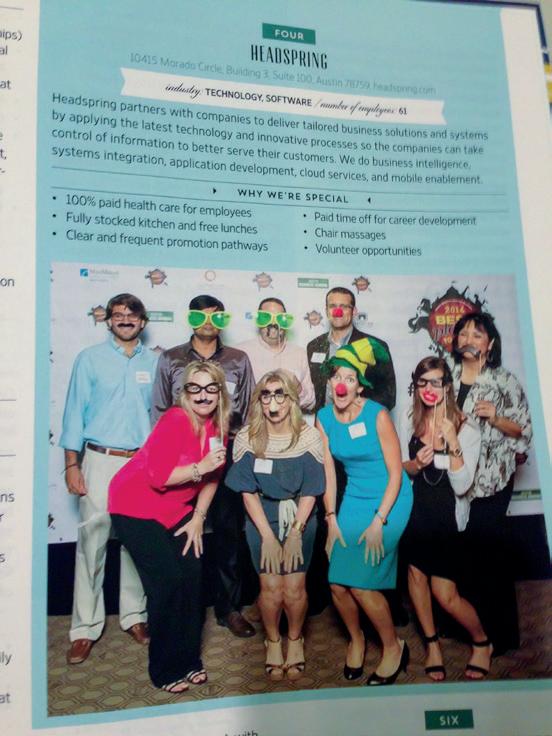
“You cannot help but feel Kelly’s passion,” enthused Chapman. “She will recruit those around her through her enthusiasm and achieve whatever the task may be. She is relentless in her pursuit, and I never doubt that she will accomplish whatever it is she sets her mind to do.”
IMPROVING SELF AND OTHERS
A believer in life-long education (as well as in life-altering pivots), Geary entered Harvard University’s extension program in 2021 to earn a certification in social justice. “I wanted to equip myself with better information to help solve problems,” she noted. “And there’s no place better than Harvard.”
Armored with that Crimson knowledge, Geary today has positioned herself where she can place a significant amount of her focus on charitable works while still at a young age. As with everything she has taken on, her drive to help make the world a better place is set at motorboat speed. “Kelly, simply
— PERPETUAL MOTION —
BEN CHAPMAN
VICE PRESIDENT, INTERNATIONAL SPORTS SCIENCES ASSOCIATION
• • • LABORA 9
Geary (front row, second from right) and Headspring team members celebrate being named one of the best places to work in Austin.
put, is a powerhouse,” said Carrie Masters, CEO of Saint Joseph the Worker, a Phoenix-based 501(c)(3) charitable organization that assists homeless, low-income, and other disadvantaged individuals in their efforts to become self-sufficient through quality employment. “She exemplifies all of the things I look up to. She carries herself with grace, she takes on challenges with no hesitation, she is dedicated to making a positive impact in our community, she is an amazing momma and truly just a great human being.”
Recently, Geary was named to the Benedictine Schools Educational Foundation Board of Directors. Her involvement with the board will certainly provide it with another fresh perspective, as well as provide her with a reason to come back to her hometown.
While Geary is involved in half a dozen non-profits, ranging from hands-on work for them to participating in and leading their boards, Geary has not abandoned her entrepreneurial roots. She has recently founded a group called The Middle League, a vehicle designed to spotlight women’s stories and to pave the way for their potential successes. “We’re trying to create an inclusive opportunity to share experience,” she said. “I want to include seasoned women who have earned that experience over the years and have them share their stories.”
Geary, in part, credits her high school days with the goals of The Middle League. “That was an all-women learning environment with all-women teachers,” she recalled. “That experience taught me that women should be leaders and should aspire to greatness.”
The Middle League, a no-fee collective that features panels and workshops, aims to do exactly that. “I encourage every woman I know to have expertise in something and to … [give] back to the world,” said Geary. “If you’re not an expert in something, become one.”
Certainly, she follows her own advice, as the expertise she has amassed is quite broad and deep. Meanwhile, we have to ask, what is next for Kelly Geary, a woman who has accomplished a great deal in a relatively short run?
Well, if baseball’s Mr. Andújar were still of this earth, he would share his opinion: “You never know.”

Rated “R” (for Robust)
PRO TIPS FOR POWERFUL INTERVIEWING
The interview, whether it be for a job or in support of a college application, has become an integral — if often feared — component of finding matches.
Having placed, literally, thousands of people in organizations, Kelly Geary is well placed to offer advice to those who are part of the interview process, whether as an interviewer or as an interviewee. But even she has known that the interview process can often fall short for either of the parties (and sometimes both) to discern an accurate picture of the expectations and the fit for the role. She knows that because of an earliercareer personal experience when she discovered a wide discrepancy in her understanding of the role and that of her new boss. Fortunately, Geary was able to move on in short order, though she regretted that “I didn’t take my own advice.”
That is a shame because her advice is darn good, whether you are new to the job market, just launching an entrepreneurial enterprise and need an extra hand, a hiring manager or seeking to make a jump within a mature industry.
Geary can share interview approaches and techniques all day long, but she notes that there is such a diversity of settings, levels and cultures that it would likely take an entire magazine to sketch out all possibilities. She makes the point however, of there being an obvious major commonality related to the process: the preparation for an interview.
Acing an interview does not equate to a job offer. Acing comes from complete preparation. Herewith are Geary’s keys — the Four R’s — to successful interview preparation (and a few pitfalls to avoid).
10 LABORA • • •
— THE FOUR R s — TO
SUCCESSFUL INTERVIEW PREPARATION
1
RESEARCH

Know the company — know the job — know the recruiter — know the hiring manager. LinkedIn is your new best friend. Find out as much as you can and discover if you have any network connections into the organization. Compile your research notes into an editable document or spreadsheet.
You are doing research for two reasons: to discover whether it
2 REACH OUT
Proactively connect with the recruiter via email to align expectations. Make sure you ask about the interview format (phone, Zoom, virtual, onsite, panel, one-on-one), the interview duration and any logistical particulars in advance. Ensure your email subject line has your full name, job title, and interview date, like this: Interview touch base: Kelly Geary, Chief People Officer, 11/8/23
That way, the email in the recruiter’s inbox will jump out with clarity, and you will have made another positive impression of your effective communication and proactive planning skills.
Also, try to learn the name(s) of the interviewer(s) beforehand, so that you may include them in your responses. Plan to ask for business cards at the start of the interview. One technique, particularly for
is a position or firm that you truly desire and to demonstrate to the interviewer that you have a strong interest in the position/firm.
a panel interview, is to arrange those cards to match who is sitting where. Bake those names into your responses. “Well, Taylor, one of my biggest challenges came when …”
Another reason for getting contact info for everyone with whom you interview is that you now are in a position to send your thanks for their time (and, again, express your interest) quickly and accurately.
3 REHEARSE
This cannot be stressed enough. It is imperative to practice. The only way to get better at anything is through practice. Interviewing is a skill with which the vast majority of professionals have minimal consistent experience. You can plan ahead for almost every single
4 READY AND RELAX
On the day of the interview, you must be ready, with a copy of your resume and the job description at your fingertips.
Are you phone/virtual interview ready? If so, you have excellent Wi-Fi, your phone/device is charged, you have eliminated all background noise.
question you will be asked, so write the questions out, have a trusted friend or family member play the role of the interviewer and rehearse. Record yourself on your smartphone — you will be amazed at the number of “ums” and “uhs” you say. Keep practicing until your answers
Are you in person/on screen interview ready? If so, you arrive 10 minutes early, you are dressed for the part and you have pen and paper to take notes.
Five minutes before go time, follow a simple relaxation breathing technique based on a 4-4-7 rhythm that will calm your nervous system. Breathe in
are tighter - focus on specificity and clarity.
But avoid over-rehearsing. Doing so runs the risk of answers coming across as canned or robotic
for a count of four, hold for four and then exhale for seven. You will feel nearly immediate relaxation benefits.
Now, you are ready to ace the interview.
— PERPETUAL MOTION —
• • • LABORA 11
Work-Life Balance? She Thinks Not.
KELLY GEARY VIEWS INTEGRATION AS MORE ACCURATE
“Time is the coin of your life. It is the only coin you have, and only you can determine how it will be spent. Be careful lest you let other people spend it for you.” — Carl Sandburg
Starting in the 1980s — and continuing into today — across the American business horizon, “work-life balance” has been all the rage. Industrial psychologists hyped the concept, titans of commerce flashed their work-life balance programs like newly minted cops flash their badges, and businessfocused periodicals sang its praises from the news racks. The famed Mayo Clinic released a study that detailed negative consequences of overwork, including fatigue, loss of focus, poor productivity, poor health, and a negative impact on relationships. Balancing work and non-work time and energy was seen as the panacea for such negative ramifications.
“God gives everyone 24 hours. Nobody gets 25. You get to choose how to divvy up your 24, however.”
There was only one problem. “Work-life balance doesn’t exist,” asserts Kelly Geary. “It’s a bill of goods we’ve been sold.”
She is not alone in that assertion. Jack Welch, the oncerevered head of General Electric was quite clear in his beliefs when he famously stated, “There’s no such thing as work-life balance. There are work-life choices, and you make them, and they have consequences.”
Geary holds a less ominous view than that of “Neutron Jack.”
In fact, she embraces the concept of integrating work-life with the rest of life’s components. She doesn’t differentiate between them, she just sees “life.” And she readily acknowledges the inherent limitations. “God gives everyone 24 hours. Nobody gets 25,” she stated. “You do get to choose how to divvy up your 24, however.”
Proponents of work-life balance champion the idea of compartmentalization, which is a fancy word for keeping one’s
work and one’s personal lives separate. Such segregation is to be achieved by creating boundaries and making conscious trade-offs between the demands, needs, and desires of the workplace with those of the home front. Of course, the hard part is sticking with the decisions concerning where and when one will place one’s knowledge, skills, abilities, and (most critically) time. The hard part comes with saying “no.”
One tip: “Instead of ‘have to,’ you can go with ‘get to,’” Geary counsels. “That can change your whole attitude.”
Certainly, there are people whose interest, contacts and actual work start and end with the punching of the proverbial clock. We tip the collective hat to such folk. But it is unimaginable that such individuals are to be found in the entrepreneurial space. Similarly, there are entrepreneurs who throw themselves into their efforts with such dedication that anything besides their work is fully ignored. The vast majority of us, however, are unable to avoid having some level of family life and other interests beyond our labors. “Remember that work and life coexist” stated Melissa Steginus, author of Everyday Mindfulness and founder of Intentional Productivity. “Wellness at work follows you home and vice versa.”
“Time is our most precious commodity,” notes Geary. “When you demand my time, make it worthwhile.” Similarly, “I try to optimize meetings if I can’t eliminate them altogether.”
“Kelly has driven a focus on meetings that are highly taskoriented,” stated Craig DeDomenico, vice president of one of the boards Geary serves on, at UVA. “Members have become closer and less regional ... and each member feels more a part of sessions versus simply listening to leadership speak at them.”
MAKING IT WORK
Geary counsels caution about how much of your personal life you bring to your work. “You need to think about what you bring to work. That’s your choice, but you need to think about it. You need to learn who you can share parts of you with. Some people you can feel safe with.”
12 LABORA • • •
The key to life integration is the recognition that there will be multiple overlaps and that such friction is to be not only expected, but fully embraced. “Boundaries do not equal balance,” asserted Geary, who recalled a position at a firm in which she was the only female executive. “The rest had stay-at-home wives,” she said. “They couldn’t grasp what I had going on in my life.
“And I’ve always had my kids aware of the work that I do.”
Geary’s family is a thriving one. Her home includes husband Andrew Wyant, and children Gigi (18 and newly enrolled at Simmons University in Boston), Cash (16) and Grace (14). She is as comfortable bouncing ideas about her work off them as she is having questions about U.S. History or algebra bounced off her. Part of that willingness comes from her goal of preparing her children for adulthood, and part of it comes from what those young minds bring to the mix: a different way of looking at things.
While she eschews the idea of an “ideal” balance and firm boundaries, neither does she surrender to a free flow between work and personal life. And she certainly urges that nobody ever confuse the two or let work issues overwhelm personal ones. “At work, we are a team. We are not a family,” stated Geary. “Teams are about work, effort and cooperation.”
While Geary draws that distinction, she is cognizant of the times her work and life may come into congruence. Nevertheless, there is nobody who is going to spend that coin of life — time itself — other than her.
“You need to think about what you bring to work. That’s your choice, but you need to think about it. You need to learn who you can share parts of you with. Some people you can feel safe with.”
KELLY GEARY
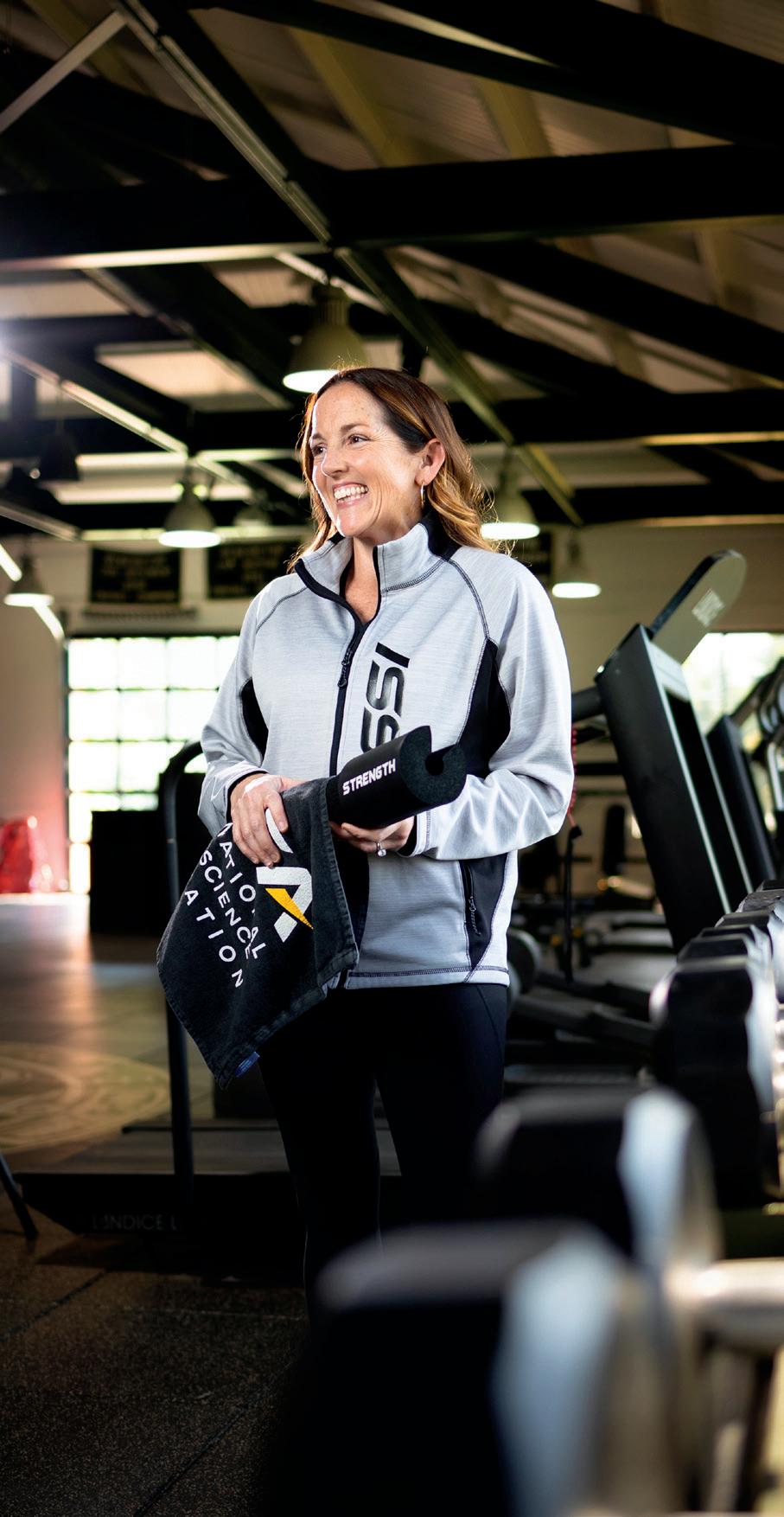
— PERPETUAL MOTION — • • • LABORA 13
Putting the “Work” into “Network” BUILDING
ONE FROM SCRATCH
LONE STAR LINKS
One of the prime rules of business is to build, maintain and grow your network. Such efforts likely begin during one’s college days, if not sooner. Of course, a large share of a network is based on physical proximity to folks with similar interests.
But what happens when you move hundreds of miles away to a place where you know nobody?
Kelly Geary has lived through such an experience three different times. Freshly out of college, she headed up to the Big Apple. Later, she landed a position in pre-boom town Austin, Texas. Still later, she pulled up her stakes to relocate to Phoenix. In all three cases, she arrived as a stranger. In all three cases, she built meaningful and robust networks.
Geary’s approach goes much further than building up an electronic Rolodex. She is noted for bringing a fresh approach to all she touches. “Kelly has made a lasting impact on ISSA by driving H.O.T. (Honest, Open, Transparent) culture,” noted that company’s vice president. “This has led to improved communication, collaboration and a clear vision among the whole company.”
Of course, in these days of globalization, it is as easy to build a relationship with someone who lives down the block as it is with a person in Alexandria, Virginia, or, for that matter, in Alexandria, Egypt. But, even with all the tools we have, local contacts are still the most critical. And upon her arrival in New York City, the freshly minted UVA grad had exactly zero. “But I’m extroverted,” said Geary. “I can talk to strangers.”
She also soon found out that Manhattan was teeming with fellow Hoos, particularly in the world of theater. That toehold soon developed into a superb network that extended well beyond Broadway and into New York’s thriving business environment.
Geary arrived in Austin “not knowing a soul,” she said. “But it was so exciting.”
That excitement served her well, and she was perfectly placed to start knowing those Austin souls. In her role as a recruiting manager, Geary’s job was to attract people to Austin. “I built my network by doing my job,” she noted. “But the competition for talent was insane.”
Whether a match she was working on was successful or not, Geary used the resultant touch points to add to her roster. And she used touch points of those touch points to extend it even further.
By the time she was through, the Virginia transplant could have made a decent run for mayor of the Lone Star State’s capital city.
Having settled nicely in the Texas heartland, Geary again pulled up stakes, as she moved to the Phoenix area. This time, she knew a grand total of one individual in that desert town. Fortunately, that individual was the man who would become her husband — a resident of the area. After meeting Andrew Wyant, she decided that Arizona was the place to be, and Geary headed for the Valley of the Sun, eager to start building another local network.
While Geary took some similar approaches and steps in all three cases, each carries a distinct differentiation. In New York, she captured contact information via pen and paper, in an address book. Her network was built in large part via the Internet when Austin-based. And her Phoenix connections were chiefly formed via social media.
14 LABORA • • •
“Network”
NON-PROFIT NETWORKING
Another notable aspect of Geary’s networking style is that it carries a purpose aside from business. And while hers has certainly served her well in her entrepreneurial forays, that network has been of great assistance in charitable pursuits. Through her board membership of the New Pathways for Youth organization, Geary invites adults to serve as mentors to teenagers who live in poverty. “It’s a simple model, but its impact has been profound,” she noted. Never one to avoid putting her money where her mouth is, she is currently serving as mentor to a 17-year-old girl in the Phoenix area. “We learn from each other,” Geary shared. “But so many other kids need mentoring. That’s the challenge.”
Another non-profit with which Geary is heavily involved is Saint Joseph the Worker, whose mission is to connect the Phoenix-area disadvantaged, homeless and transitioning individuals to quality jobs. As a board member, Geary helps the organization provide support, resources and tools necessary for those individuals to become employable.
“Lots of people have massive disadvantages,” she noted. “I want to help those people overcome them.”
In a nod to her roots, Geary also sits on boards at the Benedictine Schools of Richmond and the University of Virginia.
Geary puts full faith in the power of LinkedIn as the most powerful and wide-reaching networking tool, one that is at our ready disposal. In fact, she has created a presentation on how to best optimize one’s LinkedIn profile and shared it with numerous audiences. “She is a people connector with a vast network of amazing people,” said Saint Joseph the Worker CEO Carrie Masters, who noted that Geary’s people matching skills brought a current critical staff member to the charity, someone Masters described as a “rock star controller.”
Geary has been careful to avoid being overly reliant on technology. “I have a (physical) printout of my contacts in case anything happens,” she noted. “My network has extreme monetary and relational value.”
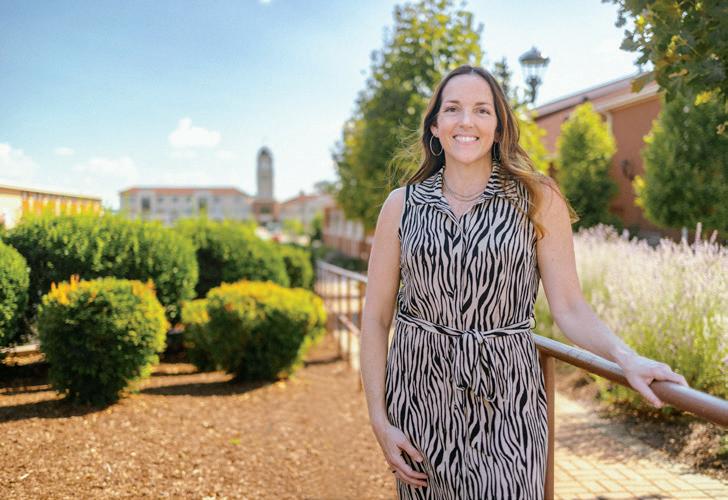
“She is a people connector with a vast network of amazing people.”
On another front, Geary has parlayed her networking skills to assist her college alma mater, in her role as president of the College of Arts & Sciences Benefactors Society Board. “Kelly has made a concerted effort to be as inclusive as possible, adjusting meetings to different times, ensuring that thorough summaries and follow-up [take place], and setting aside time to be available to whomever may need it,” said UVA’s board liaison Kevin Barry of a group that resides in four time zones (in addition to international representation) and has nearly 40 members. “She also has an ability to be in several places at once…and she will find time to pick up your call and give you her undivided attention.
“Kelly’s networking, combined with her relentless positivity and ability to personally connect with just about anyone, has elevated both the work of the board and the experience of being a board member.”
Those networking skills have impressed others on that board, as well as her “use of technology and personal touch points to drive a response rate well above historical average” noted board vice president Craig DeDomenico. “She finds a single connection to a cold call before using that shot on goal.”
And those shots? They’re invariably good.
— PERPETUAL MOTION —
• • • LABORA 15
CARRIE MASTERS CEO, SAINT JOSPEH THE WORKER
FINDING A North Star
Todd Rogers ’83 is Fueling Suburban Residential Development
If you are in the market for a new home, and if you are seeking to live in Hanover County or in the area that surrounds Hanover, there is a good chance Todd Rogers ’83 will have had a hand in what you eventually find.
Through his development and construction company and via his real estate business, Rogers is playing a leading role in shaping the controlled growth of both residential and limited commercial development north of the James River. “We feel we are making a positive contribution by providing quality homes in a beautiful area,” said Rogers, a life-long resident of Hanover County. “But we also feel we’re doing so while respecting the historical and rural roots that run deep here.”
This is no one-trick pony; Rogers’ is a fully vertically integrated steed, to belabor a simile. Rogers’ three main ventures (of many) do the following:
• Identify, purchase and prepare land for development.
• Construct homes and limited commercial buildings on said land.
• Sell those homes. (He’s also happy to sell those built by someone else.)
Nevertheless, someone who figures so prominently in the business had not planned on being so. “A lot happened by default or circumstance,” Rogers recalled. “I saw how the business affected my father’s health and didn’t think I wanted to do that line of work.”

Today, Rogers leads an effort that includes the current and ongoing realization of 17 new home developments that are in various states of completion and that range in size from 10 to nearly 300 homes. Every one of the 17 projects is in the vast lands to the northeast of Richmond. His company, RCI Builders (which he owns jointly with two other men), employs thousands of workers — carpenters, plumbers, HVAC specialists, operating engineers, roofers, masons and a host of other tradesmen — at any given time. Rogers asserts that for every 100 houses built per year, his company employs 350 workers, ranging from surveyors to finish carpenters and from excavators to landscapers.
— FEATURE — 16 LABORA • • •
Meanwhile, his Hometown Realty company (which he owns with three other men and some junior partners) has evolved into a behemoth in the central Virginia real estate market, closing sales on 3,400 homes in 2023. The real estate side of things employs over 300 agents spread over 10 offices spanning from Fredericksburg to Petersburg.
AN EARLY JUMP
Rogers has a single-mindedness that is remarkable. Even before graduating from college, Rogers had flirted with the world of real estate, helping with the financial accounting for his father’s firm while juggling schoolwork assignments and football practice at Randolph-Macon College. A year after graduation, and

driven to do so by his father’s untimely death, Rogers became the youngest licensed broker in the Commonwealth of Virginia at that time. He viewed such efforts, however, more as contingencies than as a lifelong career path.
That is the path, however, on which he would find himself. When his father passed away at a still-young 47 years of age the reins were sadly passed to the son. That burden included his inheriting an ambitious project to convert 322 acres of Hanover County farmland into a golf course. The problem was those 322 acres were not enough land for such a venture to be developed.
So, Hanover County was deprived of its version of Pebble Beach. Instead, it got Pebble Creek. Rogers pivoted and turned that chunk of turf into that so-named community of 700 single-family homes, with amenities such as an eight-lane pool, tennis courts, a fitness center, a fishing pond and two playgrounds. The community sits an easy 15-minute drive from the city of Richmond and was one of the first of its kind in the Mechanicsville area.
Bernie Meyer ’61 had been a great friend and business partner of Todd’s father, especially when it came to legal matters. Meyer recalled encouraging the reluctant son of his friend to take on the Pebble Creek project. Rogers rose to the
• • • LABORA 17
“We feel we are making a positive contribution by providing quality homes in a beautiful area.”
TODD ROGERS
occasion. “He just took over,” recalled Meyer. “He would ask for advice, but he was ‘the guy.’”
He may have been the guy, but he was still learning, and making Pebble Creek happen was not like pulling a rabbit from a hat. “I was a fish out of water,” Rogers recalled. “The zoning approval took four-and-a-half years, with 16 public hearings.” Still, his persistence and growing base of knowledge helped drive that venture’s success. “Pebble Creek put Hometown Realty on the map,” acknowledged Rogers.
Within five years, he was the co-proprietor of his own outfit, Hometown Realty, with a focus on his native Hanover County. “That was the chance of a lifetime,” recalled Rogers who partnered with Mike Chenault in that venture. Initially, Hometown’s growth was slow. In 1991, there were only five agents. In 1995, that number had grown to a dozen. Today, it is that 300-plus number.
BRANCHING OUT
In 1999, their development company spawned RCI Builders, which focused on the development and homebuilding side of things. “The real estate company (Hometown Realty) grew because of the land development company,” assessed Rogers.
One early innovation involved making the most of the “dogs of the developments.” Chenault and Rogers would take the lessdesirable lots off developers’ hands at a much-reduced price, and build on those lots, themselves, via RCI Builders. They would then sell them via Hometown.
Eventually, the pair evolved into taking on a “divide and conquer” approach: Chenault focused on Hometown Realty, while Rogers directed his primary attention to land development and construction. Nonetheless, each man has maintained a strong and active involvement in all sides of the businesses throughout their history together.
While the trajectory has been strongly positive for him, Rogers’ ride has seen its bumps and its pain. He points to the middle of the last decade as evidence of some roughing up he’s endured. At that time, his company went big in the 55+ market just as the housing market in general began to crumble, a result of the subprime nation-wide disaster. “Trying to convince someone to sell their home and buy another who is over 55 [was not happening],” he recalled.
In 2008, he moved to deplete his inventory of land holdings but, like so many others, he was caught in the landslide that came to be known as The Great Recession that peaked in 2008. “I had no idea how much money I could lose in two years,” he remembered with a trace of shock still in his voice.
Rogers lived life on the bubble as Hometown Realty executed nearly 5,000 transactions in 2007, more than it had (or has) ever done.
The silver linings from that experience:
His company experienced no foreclosures.
He never defaulted.
He left no in-process neighborhood hanging.
He was able to keep his sub-contractor workforce employed, many of whom stayed on to this day.
But those silver linings encompassed some seriously dark clouds, including Rogers being forced to let go of some longtime employees (“easily the hardest part”) while being on the receiving end of “jingle mail,” in which homeowners would mail in their keys while abandoning their homes. It got to the point where Rogers even went so far as to take out a mortgage on his own residence in order to keep his businesses afloat.
He also was innovative in his financing, keeping his businesses alive by two means in that area. First, he generated private (i.e., non-bank) financing, relying on individuals with whom he’d built up solid financial relationships over the years. Second, he engaged with the banks with which his business interests were intertwined. The pitch, according to Rogers, went like this: “Look, you can foreclose, or I can pay the interest each month, keep going and return value.”
GROWING THE FOOTPRINT
Along with Mike Chenault, Rodney Chenault and Deane Cheatham, Rogers is an owner of Hometown Realty. That quartet has led Hometown into its position as the second largest real estate firm in Central Virginia, as well as the top independent realtor in the Old Dominion.
Hometown peppers the region with offices in Ashland, Chesterfield, Farmville, Glen Allen, Ladysmith, Mechanicsville, Prince George, Richmond, Rockville, Ruther Glen and Tappahannock that are staffed by those 300+ agents. Those agents have totaled nearly 3,500 closings each year.
18 LABORA • • •
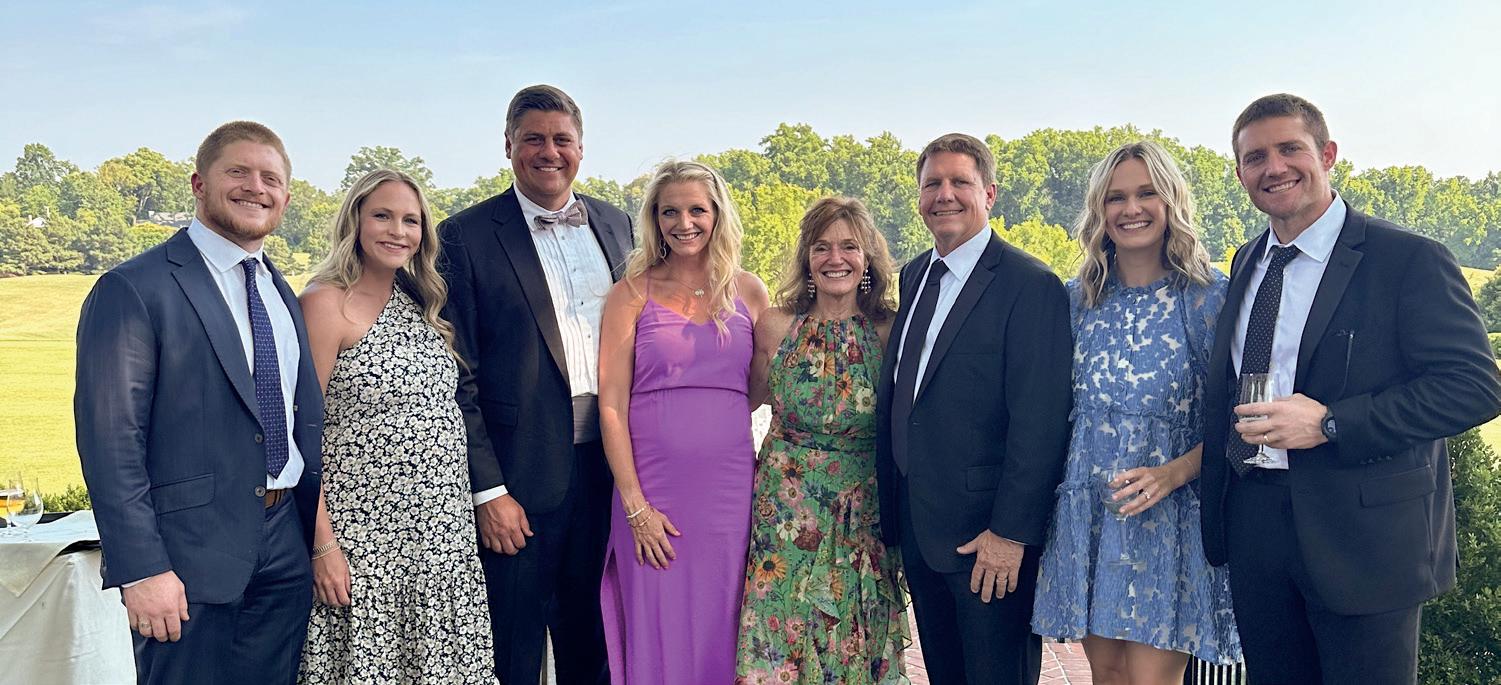
Having such scale in the real estate industry brings benefits beyond gaining listings and pulling in profit. “Hometown is a monster. We get information and understand trends well in advance of when they happen,” said Rogers. “We know the market. When I talk to my top 10 (agents), they know what is going on.”
Flexibility is key in this booming industry. “Nothing stays the same in the real estate market,” Rogers shared. “Everything has its own nuances. It’s not stable, like a production line.”
Rogers’ footprint in the northeastern section of RVA became more pronounced when he co-founded RCI Builders with Mike Chenault.
In 2012, Rogers and Chenault brought in Patrick Ashley as a full partner of RCI Builders. While Rogers still remained a strong presence at the company, Ashley’s presence allowed for fulltime oversight. The arrangement also allowed for Ashley to grow professionally. “I love working with Todd,” he declared. “While we’re business partners, the real relationship is that he’s my number one mentor. He does a lot of coaching.”
As RCI’s staffing model is based on being a company of leaders who manage an army of contractors and subcontractors that number into the thousands, those leaders must be strong, and they must be flexible.
RCI is widely seen as a leader across RVA in the area of one-level homes and two-stories with a first floor master bedroom. That reputation has paid off handsomely as such homes are ideally suited for a local population that is both growing and graying. The first floor master units work well for young, growing families, while the one-story homes are perfect for senior citizens who are averse to the idea of climbing many stairs.
GIVING BACK
But what separates Rogers from other developers/builders/ realtors may have nothing to do with land and houses. “What makes Todd unique is the amount that we give back to the local community,” said RCI partner Patrick Ashley. “That is driven by Todd.”
The approach to his good deeds mirrors that of his approach to his work: take on projects and see them to fruition. Some of those projects have included building and donating a fully accommodated house for a local disabled combat veteran and his wife and two children, building and donating the Hanover County Courthouse Park’s concession stand and restroom facilities and sponsoring Operation Healing Forces, which enables Special Forces soldiers to take a well-earned vacation from the grind of going after the bad guys. A current effort involves building and donating a 3,200 square-foot pavilion for “latchkey kids” to use over the summer at the Atlee YMCA.
It would be easy to attribute Rogers’ largesse to building goodwill among the community in which he works and lives. There is more to it than that, however, much more. He and his wife Becky, parents of three and grandparents of seven, are parishioners of Saint Mary’s Catholic Church in Henrico. They take their faith seriously, across all aspects of life. Rogers shared that “daily prayer starts my center line every morning between 4:30 and 6.”
“My faith guides me in every decision that I make,” declared Rogers. “No matter how the bullets are flying at work, I always refer back to my center line, which is my belief that He is in control. There is no obstacle or situation in which I will not rely on Him.”
— FINDING A NORTH STAR —
• • • LABORA 19
Left to right: Sam and Lauren Rogers, Lane and Madison (Rogers) Medlin, Becky and Todd Rogers, Emma and Benjamin Rogers.
Is Bigger Better? No Matter —
It’s Here to Stay
INCREASING UP-FRONT COSTS DRIVING MOVEMENT TOWARD LARGER HOMES
Over the recent past, the U.S. has witnessed an explosive growth in housing, both in terms of total units and in the costs of those units. While that boom certainly pertains to the number of developmentbased houses, it is more apt in referencing the physical size of those houses. A casual drive through a burgeoning suburb might confirm those assertions.
Growing families are not the cause of this phenomenon. In fact, from 1960 to 2022, the size of the average American household has declined by nearly 25 percent. Meanwhile, over that same period of time, the average newly constructed single-family house has increased its square footage by a whopping 60 percent.
ECONOMICS OF HOUSING
So, why the square-footage inflation? Certainly, a change in tastes accounts for some of it. After all, granite countertops, outdoor spaces and sunrooms come at a cost. Affordability, or at least the perception of affordability is another factor. Americans have fallen into a pattern of considering their monthly payment, rather than the entire price tag. The run (until recently) of low interest rates drove suppressed mortgage payments, which allowed buyers to pursue bigger and grander homes.
FIXED COSTS AS A DRIVER
A major factor, however, is less obvious to the untrained eye: a new home’s fixed costs contribute mightily to the home’s price tag. Those costs have risen dramatically, pushing developers and builders to shift toward larger homes, and pricier ones (see accompanying chart). SOURCE:
50% 100% 150% 200% U.S. Consumer Inflation RVA Wages RVA Housing 2000 2005 2010 2015 2020
RESERVE ECONOMIC DATA (FRED), ST. LOUIS “RVA” refers to the Richmond Metropolitan Statistical Area 20 LABORA • • •
FEDERAL
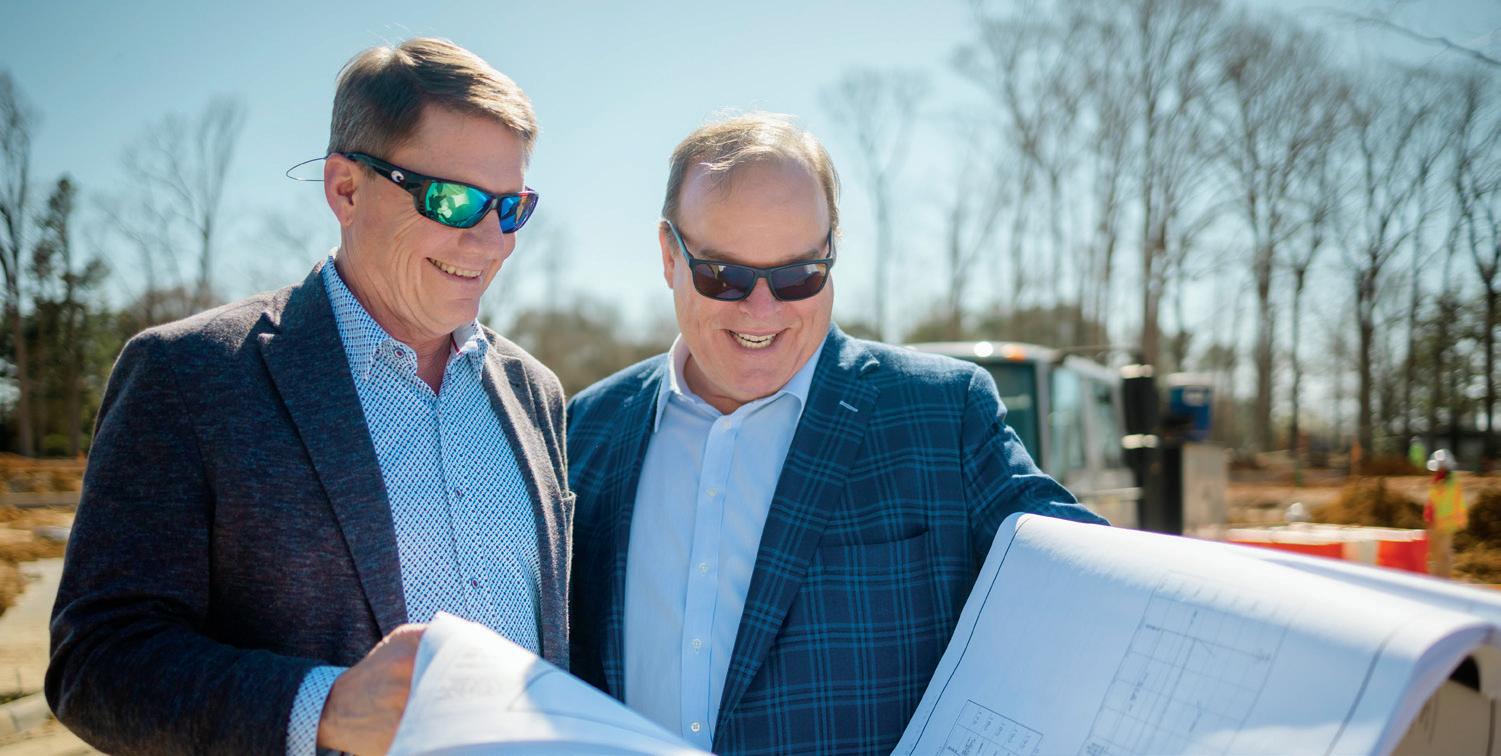
Here is how.
A new house, no matter the size, its style, its composition or its amenities has a considerable number of the same inputs as any other in a set area. If a company is building a 4,000 square-foot brick home with a slate roof, a three-car garage and stained-glass windows and also building a 1,000 square-foot bungalow with a car port next door, the two projects would have the same “start-up” costs. “It’s hard to build a small house on an expensive lot,” noted Todd Rogers.
Those costs, obviously, start with the purchase of the land on which the homes will be built. Rogers stated that per lot costs have reached $140,000 on average lately. That cost alone can drive a smallish (1,100 square-foot) home to price out in the $300,000 range. But land cost is just the start of the parade of checks a developer has to write. He or she needs to prepare the land, and that preparation starts with determining engineering and environmental constraints, which will establish boundary lines, building setbacks (where the house will sit on the plot) and fence lines. Often, a developer must undergo a rezoning process, as well as permitting to satisfy the county or city government.
Costs that support the actual development are plentiful and are born by the developer before he has seen a nickel. They include:
Engineering inspections, such as soil testing
Earthwork, such as blasting and excavation
Leveling and grading
Road bed preparation (the developer is on the hook for building the streets)
Water and sewage lines
Trenching costs for utilities
Meter installation costs for electricity and gas
Todd Rogers and Mike Chenault consult on one of their collaborative projects.
Connection fees for water, sewer, gas and electric services (Rogers shared that Hanover County charges $15,000 to connect a new home with a water meter and that other counties charge a similar fee.)
Septic and well services if no main line access
DEQ and Corps of Engineers: permits, permits, permits
Again, all of those costs are borne by all the homes in that development equally. For illustration’s sake, let’s say all of those fixed costs work out to $200,000 per house. For the earlier-cited example (the 4,000 square-foot home), let’s say the price tag is $1 million, and the smaller house is $300,000. In the first example, fixed costs account for 20 percent of the total price. In the second, those fixed costs represent a whopping two-thirds of the total price.
AN ANALOGY
In a way, it is comparable to viewing the membership at Costco as a fixed cost. If you paid the fee to join and only bought a few inexpensive items, that fixed cost would be a huge percentage hit to your total spend. Conversely, if you were to do your weekly grocery shopping there, that initial Costco membership fee would be a miniscule percentage of your total annual spend there.
Oh, and all of those fixed costs are borne by the developer who only sees a cash inflow when those homes are finally sold. Rogers somberly noted, “There is not a payday for years.”
Until we see a drop in the cost of land, inspections, infrastructure design and build, service fees and permits, the current trend toward the construction of larger homes seems likely to continue, unless localities become more amenable to a higher level of residential density, which would help drive those fixed costs down.
It’s just a matter of economics.
— FINDING A NORTH STAR —
• • • LABORA 21
Gridiron Makes for Some Jolly Rogers(es)
PIGSKIN PEDIGREES PREVALENT, PARAMOUNT
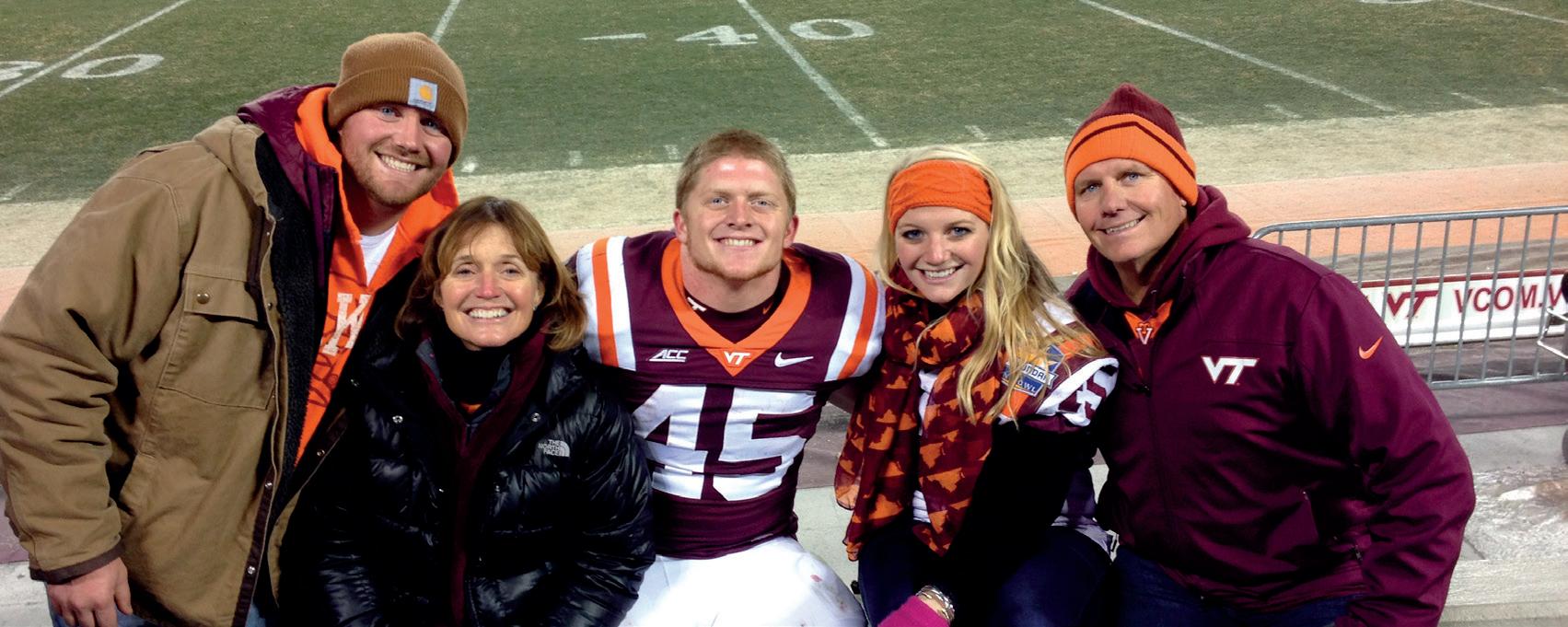
It would be fair to state that real estate and construction entrepreneur Todd Rogers has a good ground game. After all, he has developed, improved or sold hundreds of acres (and the structures upon them) over the years. It would also be fair to state that he comes by his focus on the ground game honestly, with a foundation in football.
Rogers has deep roots in the game, as do his sons. After making his mark as a linebacker and tight end for the Cadets, Todd played linebacker at Randolph-Macon College. Highlights of his time on the Yellow Jackets’ defense included making key stops against Hampden-Sydney in Randolph-Macon’s 31-10 thrashing of the Tigers, a win that gave the Yellow Jackets the conference championship and a berth in the Division III playoffs during Rogers’ sophomore season.
The oldest child, Benjamin, may have risked breaking his father’s heart when he opted to enroll at archrival Hampden-Sydney, but his decision was driven by a desire to live a bit farther from the family’s Hanover County home while still suiting up for a college team.
It all worked out for the best, however, as Benjamin, an offensive lineman, pancake-blocked his way onto the all-conference first team four years running. He helped power Hampden-Sydney to a 35-8 record (and two ODAC championships) over his four years as a starter. His most notable achievement, however, may well be his being awarded the Gammon Cup at graduation. This prize was awarded to the member of the graduating class of 2012 who had best served the college through character, scholarship and athletic ability.
Benjamin is currently a team leader and junior partner with Hometown Realty, again following in his father’s cleat-steps. He also appreciates the impact his father had on his game. “Despite a packed schedule, Dad coached me for five years of youth football,” said Benjamin, adding that his father also coached his brother on the gridiron and his sister on the softball diamond. “He had superearly mornings and super-late nights, but he’ll do it all for family.”
Third child, Sam, was a walk-on for the Virgina Tech Hokies, yet he earned playing time during his freshman year, working
22 LABORA • • •


his way into a scholarship. The rugged fullback eventually rushed for nearly 700 yards and hauled in 72 receptions for another 800 yards. Noted for his exceptional blocking skills, Sam (a quarterback in high school) also connected via the air when he pitched the pigskin on fullback options, including a scoring strike that helped ice a victory over Miami during his senior season.
A favorite of the Hokie faithful during his time in Blacksburg, Sam was drafted by Los Angeles after his senior year, and he went on to hold a spot on both the Rams’ and the Buffalo Bills’ team rosters.
Sam currently heads up the football program at Hanover High School, where Dad helps out by coaching the defensive backs and special teams. Previously an assistant coach at Benedictine, Sam led the Hawks to a mark of 8-4 during the 2023 campaign.
And the middle child? Daughter Madison “wanted to go south and see some big football,” remembered Todd.
“He had super-early mornings and superlate nights, but he’ll do it all for family.”
She graduated from the University of South Carolina, where she had the opportunity to attend mighty Southeastern Conference football games. These were the days when Steve Spurrier was the head coach of the Gamecocks. Meanwhile, Madison continued cheering on her brothers’ exploits from afar. “She is the biggest rock of the family,” said her dad.
Speaking of seeing games, Todd and Becky became road warriors during their sons’ collegiate careers. They saw every single H-SC game during Benjamin’s run there. They thought they might catch a break, since Benjamin’s final season was in 2012 and Sam entered Tech in 2013. But with Sam earning playing time his freshman year, a four-year string of sojourns began. In all, they hit every single one of Benjamin’s games and all but one for Sam. In what amounts to a massive understatement, Becky declared, “We love watching sports.”
With seven grandchildren (all under the age of five), she and her husband should have ample opportunity to do just that. And chances are, it will include plenty of football.
— FINDING A NORTH STAR —
BENJAMIN ROGERS
Sam Rogers
• • • LABORA 23
Benjamin Rogers
All in the Family
THERE IS A LOT OF LOVE HERE
We often hear groups described as “family.” It might be a member of a sports team who refers to his or her teammates in such a fashion. It could be the leader of a military unit who has seen the group’s camaraderie grow to where it merits such a description.
Todd Rogers is one who wholeheartedly believes that the culture of his Hometown Realty group is family. Also true: Rogers’ son Benjamin is a team leader within the group, while other son Sam also does some work for Hometown, among his other gigs. But the feeling of family at Hometown, RCI Builders and Rogers’ other ventures extends well beyond bloodlines.
Of course, Rogers puts his true family first, acknowledging that his success has largely been driven by the support of his wife, Becky. “The cliché is true,” he noted, referencing the classic “Behind every good man is a great woman.”
The two became a couple when both were juniors at Saint Gertrude and Benedictine. In fact, in an early manifestation of togetherness, the pair was named king and queen of the senior prom, with Todd to this day insisting that he rode Becky’s coattails to that coronation. While Becky went off to Mary Washington before transferring to UVA, Todd headed to the closer Randolph-Macon College. After college graduation, the two graduated to nuptials, 36 years ago.
“Faith, family, football” is a credo by which Todd lives. “No one has been my coach — on or off the football field — longer than my dad,” shared Benjamin Rogers. “And if you’ve ever thought of me as a good leader, everything I know is from him. He’s humble, he’s a servant, and he’s locked in on the little things we all know it takes to be successful.”

He is also a teacher of sorts. Benjamin notes a lesson that he has learned from his father: “A win at work is never worth a loss at home.”
PARTNERS AND FRIENDS
Rogers has three ownership partners at Hometown Realty: Mike and Rodney Chenault and Deane Cheatham. It is a good thing they get along so well, because all four of them live within a single mile of one another — as did all of their children. “They are essentially cousins,” noted Rogers. “They all grew up together.” In a way, so did the four partners. When interacting, they share a deep common history and can finish each other’s stories without missing a beat.
Here is another connection: Becky Rogers introduced Mike Chenault to the woman who would become his wife. Becky and Kate Duke
“Everyone is family-oriented, and all of our employees will do anything for each other. I’ve seen Todd help others who are in financial need. He is a gracious man who is always there for you.”
JACKIE FIELDS
24 LABORA • • •

Chenault became friends during their time at Saint Gertrude and have maintained a friendship as durable as that of their husbands.
While connections and partnerships are all well and good, and having a desire to instill a feeling of camaraderie in the workplace is admirable, there has to be more to it. Rogers seems to fill the bill. “He has always wanted us to be respectful of others,” noted comptroller Jackie Fields. “Everyone is family-oriented, and all of our employees will do anything for each other. I’ve seen Todd help others who are in financial need. He is a gracious man who is always there for you.”
Rogers has many more fans, along with Fields. His longtime corporate attorney Bernie Meyer is included in that count. “If I could pick a third son, I’d pick Todd,” he assessed. “He’s just a right kind of person. He’s honest, straightforward, smart and good-looking.” Meyer then added with a chuckle, “Well, at least Becky thinks so.”
Hometown Realty goes to extra lengths to extend the family concept. For instance, Mike Chenault points out that the company was noted for its “pig cooker,” a trailer-mounted behemoth of a barbecue grill that the company has employed in having “kickoff” celebrations for subdivisions. “It was before we even had sewer
Todd and Becky Rogers with their seven grandchildren.
“He’s humble, he’s a servant, and he’s locked in on the little things we all know it takes to be successful.”
BENJAMIN ROGERS
lines, so we’d have a porta potty, barbecue and keg beer,” he recalled. “And 100 people would show up, and we’d sell seven or eight lots.”
And those newbies were certain to be treated kindly. According to Becky, “Todd loves his job, especially when it comes to first-time home buyers.” Rogers pleads guilty as charged, adding, “It’s the start of their lives together with their biggest investment. It is so much fun to work with them.”
Employees can expect the family treatment, as well. “During my second year of working here, my husband (a captain in the Army National Guard) was deployed overseas for a year, which left me at home with two very young children (five months and two and a half years old),” recalled Kristin Parrish. As his executive assistant, Parrish has the unenviable task of trying to keep Rogers’ schedule, among other things. “The amount of support I received from Todd, his wife Becky and my coworkers was overwhelming,” she noted, “Todd always has said ‘family first’ and has been very compassionate and understanding when it comes to family obligations outside of the office.
“It has been such a blessing.”
— FINDING A NORTH STAR — • • • LABORA 25
A Man of Many Partnerships
ROGERS IS THE OPPOSITE OF THE LONE WOLF
The Guinness Book of World Records tracks several categories of juggling. For instance, England’s Alex Barron set a world record when he successfully juggled 14 beanbags in 2017. Fifteen years earlier, America’s own Albert Lucas set the world record for juggling rings, when he did so with 13.
These stars of the world of juggling have nothing on Todd Rogers. Beanbags? Rings? Heck, Rogers is juggling 32 companies in which he has an ownership stake. Those 32 companies range from the small and simple (such as a company that owns the property that houses his office) to the vast and complex (RCI Builders). Here is the thing, though — the ownership of each of those companies involves at least one other partner for Rogers. “I’ve never done anything by myself,” he shared, thus breaking the stereotype of the go it alone entrepreneur. As Rogers points out, why go solo when there is so much to be gained in partnership?
One of the primary gains comes in the form of enhanced thinking. “If I have two partners, [together] we have three brains,” he shared. “And that brings collaboration.”
Rogers readily avers that such brainpower and teamwork far outweigh the fact that the profit he receives is but half or a third (or much less).
His portfolio of companies means Rogers is a businessman who cannot be depicted in monochrome. The headliner businesses include land development (which he co-owns with Mike Chenault), home building (which he owns jointly with Chenault and Patrick Ashley) and home selling (which he owns with Mike Chenault, Deane Cheatham and Rodney Chenault — Mike’s younger brother).
THE START OF A BEAUTIFUL FRIENDSHIP
By far, the longest and most fruitful partnership involves Rogers and Mike Chenault, which started in 1988. Chenault, who began working at Hometown Realty under his mother (who was owner of the small brokerage at the time) is Hometown through and through. “What Hometown is to me … it is me,” stated Chenault during a group discussion. “I can’t imagine any other way. I have two legs, two feet and one job.”
The two were familiar with one another through football — Chenault played for Hampden-Sydney while Rogers suited up for archrival Randolph-Macon — and through both being Hanover boys. Their partnership is based on mutual respect and admiration. “If Mike knows you, and he doesn’t have to know you well, Mike will do something extraordinary for you,” said Rogers. “Whether it’s in a time of need, or you just need someone to talk to, he’s the guy to talk to.”
Bernie Meyer served as a mentor for Rogers and as an attorney for Rogers’ and Chenault’s business interests. “When Todd and Mike met, there was no looking back after that,” Meyer marveled.
“Todd and I are two of the hardest-headed people I know,” assessed Chenault. “God knows we should have quit long ago, if you look at what’s happened the last 15 or 20 years in the world of real estate. But we’re not quitters.”
Other companies of Rogers’ include a property management business, a homeowners association management venture, and a mortgage and title business. According to Rogers, those two lines have low profit value, but they serve a greater purpose. “They make for customer service more than anything else,” he assessed. “Through them we offer an extra level of service. We can also give incentives to make things run smoother.”
“I have come to realize that the distinction he makes shows the character of the true leader he is. He leads by example and believes that we are all on the same team, no matter what our role is.”
PARRISH EXECUTIVE ASSISTANT, RCI BUILDERS
26 LABORA • • •
KRISTIN
“Todd and I are two of the hardest-headed people I know. God knows we should have quit long ago, if you look at what’s happened the last 15 or 20 years in the world of real estate. But we’re not quitters.”
MIKE CHENAULT
Note the use of the word “we.” Whenever Rogers speaks of his business ventures, “we” and “us” are what you hear. There is scant little in his galaxy that he stakes out as an individual. “Over the years, I have heard Todd say that I work ‘with’ him, not ‘for’ him when speaking to others,” said Kristin Parrish, his executive assistant. “I have come to realize that the distinction he makes shows the character of the true leader he is. He leads by example and believes that we are all on the same team, no matter what our role is.”
FELLOW JUGGLER
Meanwhile, Rogers’ partner in his juggling performance is Jackie Fields, who has served as his controller for over 30 years. Thirty-two companies mean 32 of everything, which might seem daunting. But Fields is a cool and confident controller. “He trusts me,” she said, “and that means a lot.”
Fields has also seen Rogers’ approach pay off: “More partnerships really helped, especially in the early days. They opened doors.”
Though no glad-hander, Rogers may well be one of the least introverted people you are likely to encounter, as he draws so much of his energy from being with other people. He seems self-aware of that trait, as he notes that working in partnership has built many a friendship and “that is a fulfilling part of my life.” That life fulfillment extends beyond the office and the building site. “My wife and children are my partners,” he noted. “My Benedictine classmates are good buddy partners.”
A corollary to Rogers’ mantra of “faith, family, football” seems to be “partners.” Rogers readily acknowledges the importance of partnership and the role it has played in his life, noting, “Not going alone has helped me succeed in a lot of ways.”
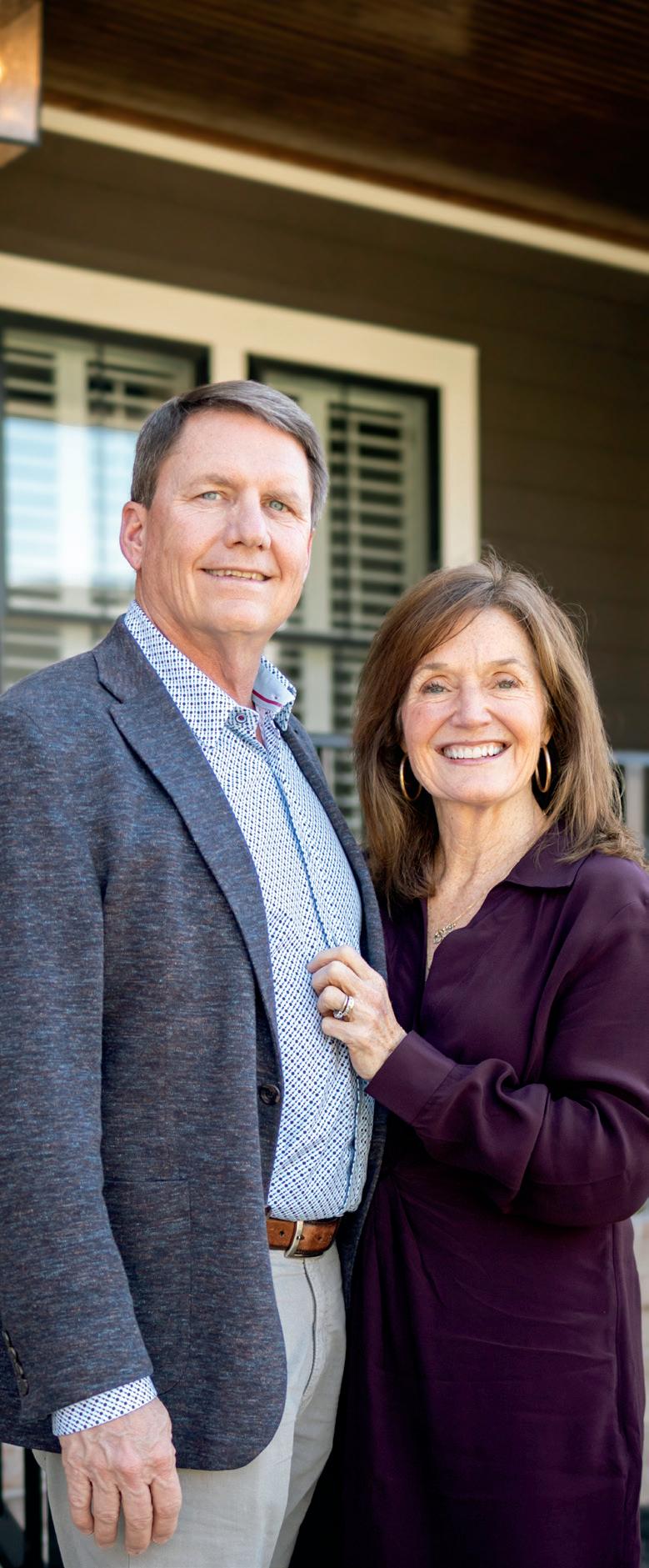
— FINDING A NORTH STAR —
• • • LABORA 27
Todd and Becky Rogers

GUIDING CHANGE
Alums Play Big Role in Helping Foster Kids Face Adult Life
— FEATURE —
28 LABORA • • •


hey labor for those who often have few who will do so on their behalf. In fact, they
have each used the entrepreneurial skills they honed along the way in building non-profit organizations that strive to make life better for those in foster care. More specifically, they are focused on an especially at-risk population — those who are transitioning out of the foster care system. “My hope is that
Anyone in foster care, whether in a foster home or not, ages out of the system on his or birthday. And while there are programs in place to help, many still face a daunting future — one for which they are ill-prepared, especially those who have experienced
Said Powers,“We’re trying to have an impact on the macro level, in addition to the micro
• • • LABORA 29
“These are life-skill camps. We emphasize home economics, apartment finding and funding, money management and budgeting. They need to be ready to live like adults.”
CHALLENGES ABOUND
Durham and Powers (and friends) have a lot to overcome. Virginia stands as one of the three worst states for those aging out of foster care, according to data provided by Voices for Virginia’s Children. Unfortunately, the Commonwealth has held that position for the past decade, with Virginia’s transitioning foster children lacking permanent connections, experiencing a dearth of college experience, having poorer workforce outcomes and seeing higher levels of incarceration. Virginia is joined by Maryland and Delaware in this dreadful distinction. (The three states with the highest ratings are Wyoming, West Virginia and Mississippi.)
True, Virginia does have a program to assist with the transition. Though the state’s Fostering Futures program provides something of a three-year lifeline, it comes nowhere close to placement within a home. At 21, former fosters are squarely on their own. “I would like to have those who are transitioning have as much of a normal life as possible,” said Durham. “And I want to help them toward transition before they leave the system.”
SOME SOBERING STATISTICS
While 54 percent of the nation’s foster children will graduate from high school (compared with 79 percent of all American youth), only three percent will go on to earn a bachelor’s degree. Even worse, one in five will be homeless within a year of leaving foster care, half will be unemployed by age 24 and a full 25 percent will be incarcerated within the first two years. Lastly, more than 71 percent of women who leave the program will become pregnant by the age of 21.
The rules of the various systems that guide the foster care programs, and America’s changing demographics, put those who are aging out of the system in an increasingly precarious spot. According to the Wall Street Journal, 21 percent of people between the ages of 25
54% GRADUATE HIGH SCHOOL 3%
EARN A BACHELOR’S DEGREE
1 in 5 WILL BE HOMELESS ONE YEAR AFTER LEAVING FOSTER CARE

Christi Durham brings joy to all her efforts.
50% WILL BE UNEMPLOYED BY AGE 24
71% WILL BECOME PREGNANT BY AGE 21
25% WILL BE INCARCERATED WITHIN TWO YEARS
CHRISTI DURHAM
30 LABORA • • •
and 29 years still reside in their parental home. The same research finds that 31 percent of young adults depend “a great deal” or “a fair amount” on a parent or parents for emotional support.
Meanwhile, according to the Pew Research Center, a third of adults in their early 30s are still financially dependent on their parents, with 44 percent of young adults (21+) stating that they had received financial help from their parents in the past year. The Center also found that 57 percent of those aged 18-24 still lived at a parent’s or parents’ home, which is an increase over the past 30 years.
The bottom line:
While the overall population increasingly relies on the stability of their parents, and does well into adulthood, foster children are pretty much on their own once they hit the minimum level of adulthood.
The reason so many live at home is likely driven, in part, by the lack of earning power among that demographic. According to the federal government’s Bureau of Labor Statistics, 20- to 24-year-olds have average pre-tax earnings of $720 per week (or $37,440 per year).
A study by the Annie E. Casey Foundation found that 24-yearolds who had transitioned from foster care earned an average of $10.17 per hour while averaging 40 hours of paid work each week. That works out to an annual income of $21,154, or 56 percent of the average income for that age group.
Durham and Powers know all these facts and figures. Both know they are daunting. Both know that the problems are persistent. And both have taken an innovative approach in making a difference.
DURHAM HAS BEEN THERE
Durham ’92 started Fostering Hope RVA three years ago, in an effort to provide acute and timely assistance to foster children who were on the cusp of adulthood. Her desire to do so stems from a simple, yet crucial, fact — she was once a foster child herself.
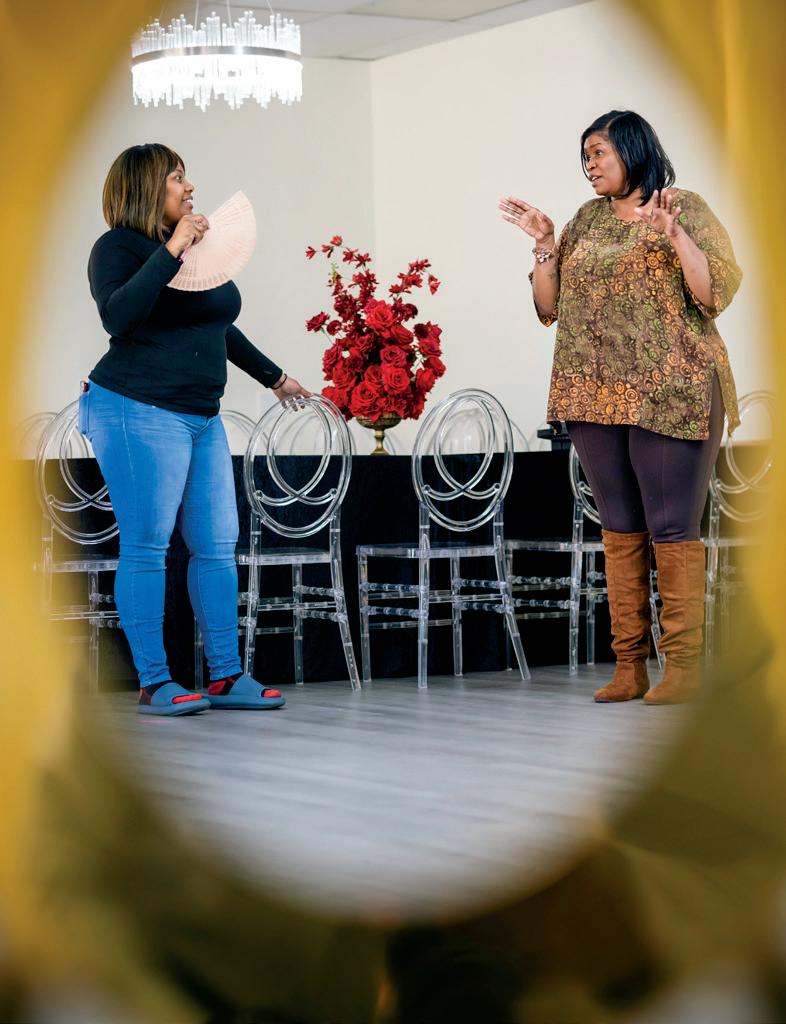
Fostering Hope’s seal consists of an anchor, representing hope; a rose, representing love (Durham’s adoptive mother’s name was Rosa); and a pearl, representing wisdom (Durham’s birth mother’s name is Pearl). Durham develops hope, love and wisdom through the focused delivery of services Fostering Hope provides.
The organization conducts several camps throughout the year that focus on building an appreciation for, and an understanding of, adult level life skills, such as acquiring and keeping housing, job hunting, maintaining personal finances and learning of the (few) programs that will still be available to them in their young adulthoods. “We’re trying to gauge an interest toward something that might turn into an apprenticeship,” Durham noted.
Campers are referred to Durham by the Department of Social Services and from other nonprofits that are involved in the foster care system. Those who get to participate are able to learn things that their non-foster peers might not experience for years. “These are life-skill camps,” stresses Durham. “We emphasize home economics, apartment finding and funding, money management and budgeting. They need to be ready to live like adults.”
“We took the camp participants to an apartment complex and toured an apartment,” recalled Jennifer Stith, who voluntarily coordinates the events for Fostering Hope RVA. “We discussed
— GUIDING CHANGE — • • • LABORA 31
Event planner Tia Thorne (left) and Christi Durham discuss a collaborative event.

Resilience, thy Name is Christi
DURHAM’S TOUGHNESS PREVAILS OVER LIFE CHALLENGES
The license on her car reads “NOT-W8N.” And Christi Lilly Durham ’92 is living that brief and clever plated statement. She is the opposite of one who waits — patience is not counted among her many virtues.
What is included in that list of virtues is her desire to give back, particularly to those who share the path she has travelled. Durham has taken a life’s journey that was — to say the least — bumpy. She used the lessons she learned along it to craft a mission: helping foster children as they transition into adulthood. The opportunities for Durham to learn those lessons were manifest. Through the non-profit she has founded — Fostering Hope RVA — Durham seeks to bring innovation in assisting a historically underserved population. Her focus is on the greater Richmond area’s older foster children as they prepare to enter adulthood. “Christi is very dedicated to her cause, which is giving hope and a sense of normalcy to foster children,” noted BéBé Tran, who is a foster parent specialist with Commonwealth Catholic Charities, focusing on unaccompanied refugee minors. “She also wants to connect and empower them.”
Born to teenage parents, Durham was placed for adoption as an infant and at six months of age was adopted (after being first foster parented) by Herbert and Rosa Lilly, who lived in King William County. “I had a great foster family who adopted me,” she noted. After completing grade school (All Saints and Our Lady of Lourdes), she matriculated at Saint Gertrude High School where she “was very much a wallflower,” according to Durham.
Prone to socializing with a small clique of fellow Gators, Durham shared that the group was a quiet one. Nevertheless, she did draw the positive attention of faculty and staff, including biology teacher Mary Anderson, theology teacher Cathy George and principal Sister Charlotte Lange, O.S.B., who would play a major role in Christi’s life in the near future.
A BUMPY ROAD
Three years after high school graduation, Durham found life taking a bad turn. Her adoptive mother passed away during that year (1995), and Durham lost her source of inspiration. “I attribute the things I do with kids today and use the same style I saw my mom use,” she said. Sadly, Durham found she had also lost her passion for college. Instead, she took to working multiple jobs to make ends meet. A year later, a bad relationship took its toll.
“When I was with him, I went downhill,” she recalled. “It cost me a job, and I got evicted in the same month.”
Young, adrift and pregnant, Durham found help through Commonwealth Catholic Charities, which put her in touch with resources to assist her. Also, “Sister Charlotte threw me a baby shower,” Durham recalled. “And alumnae donated to that.”
Her former principal, somehow, was able to find Durham a van for work, which the young mother put to use in getting her to jobs at Food Lion, Cox Insurance and a cleaning company.
Sister Charlotte successfully called on the SGHS faculty and staff to help supply their former charge with furniture and supplies to help with Durham’s living situation. “It is amazing how resilient she has been,” marveled Sister Charlotte.
Things were slow to improve, as the young mother found herself, along with her son Brandon, living in public housing. “It was a culture shock,” said Durham,
“Christi wants to bring tools to kids who might have had to handle trauma. She is working for a cause that is sometimes forgotten.”
FARMER RADIO HOST 32 LABORA • • •
BARRY

who was robbed (on Thanksgiving Day, no less) and assaulted during separate instances while living in Richmond’s infamous Gilpin Court. “I promised my son we would get out of there.”
She kept that promise through sheer grit in the face of odds that would have many throwing up their hands in despair and frustration. Durham capitalized on the Section 8 program, jumped into an experiment the state was running and pushed for home ownership. Between jobs and motherhood, she took mandated classes to earn assistance with a down payment. She endured a three-year run in an apartment complex where domestic violence was commonplace, which only motivated her more strongly to buy her own home. Finally, that dream became a reality when she moved into a home built in the 1980s.
That experience gave Durham a positive regard for the world of real estate and its management, and she dove into that field, working as a property manager.
In 2005, she married Anthony Durham (“a good guy,” assessed Christi, about the father of her second son, Aaron).
Her first jaunt into the entrepreneurial world came when she and Anthony purchased the gift shop at Henrico Doctors’ Hospital. The couple threw themselves fully into the venture, even purchasing a home that sits right behind the hospital’s grounds. “We wanted to make it a prestigious gift shop, like the one at Saint Mary’s [Hospital],” recalled Durham. “We wanted more than just flowers, cards and candles.”
Again, however, adversity struck. Six months into their ownership, hospital administration informed the Durhams that they planned on
doing away with the gift shop. The in-force contract the Durhams inherited was denied renewal, and they donated a good chunk of their inventory to Goodwill.
GRIT AND GRACE
Yet, Durham sprang back. From the remnants of the gift shop business came Christi’s Creations. Starting with her building gift baskets for relatives and friends, the business grew to one where she was creating such treats for local companies. That, in turn, led Durham to start up Glam R Us, which she has managed for the past dozen years. Its genesis came in the form of Durham putting together a “ladies’ night” fundraiser for a Saint Gertrude classmate’s kidney disease treatment.
Durham went on to host additional ladies’ nights and to start organizing like events. Eventually, she moved operations from a temporary home at the Links Clubhouse, in Glen Allen, to set up a permanent venue located in the northern section of Henrico County. She continues to offer end-to-end services, including event planning, coordination and day-of execution.
Three years ago, Durham felt she had the breathing room to start up Fostering Hope RVA, and she has been with it ever since.
Along the way, Durham befriended Barry Farmer, the host of the eponymous syndicated morning radio show that is carried on 25 stations across the country. Farmer has collaborated with Durham on several fundraisers and helped with some of Fostering Hope RVA’s classes. “Because of her experience, she is very passionate about what she’s doing,” noted Farmer. “She’s lived it and has seen the emotions involved.”
Farmer has “lived it,” as well. He has adopted three children of his own, is the spokesman for Adopt Us Kids and is an advocate for children awaiting adoption. He has also created one of the largest online support groups for foster care and adoptive families.
Noted Farmer, “Christi wants to bring tools to kids who might have had to handle trauma. She is working for a cause that is sometimes forgotten. And she is effective. She interacts great with the kids, and they really take to her. They trust Christi and can be themselves.”
“Christi is very pleasant to work with,” added Tran. “She is a very caring, kind and generous person.”
Those fine attributes come from a lifetime of experience honing them. Durham recalled, “My parents always told me, ‘You think you don’t have enough. But you always need to see there are others who wish they have what you have.”’
— GUIDING CHANGE — • • • LABORA 33
“I felt I needed to make a difference. I’d spent lots of time on boards but now wanted to make a real impact. I had been staying in my comfort zone.”
DON DELANEY
prices, which really surprised them. Then we ran through a budget. It was a great activity for them to see what they’ll face and learn what it takes to pay the bills.”
“Fostering Hope RVA provides our children with independent living skills training and normalcy,” said BéBé Tran, of Commonwealth Catholic Charities. “Attending Fostering Hope camp has helped our children improve their social skills as well.”
There are some fun aspects to the camps, as well. Some of these have included exposure to karate, photography, baking and floral arrangement. Durham has arranged guest presentations from local business representatives, including Towne Bank (through their course titled “The Art of Saving”) and Chick-fil-A (on the topics of interview skills and resume building). Fostering Hope RVA also has a “Secure the Bag” program that provides those transitioning from foster care with a good number of life essentials.
INVESTING IN THE FUTURE
Durham hosts the camps primarily at her building, which is home to her Glam R Us events business. She plowed $30,000 of her own money into improving the facility. From there, she coordinates, plans and hosts a wide range of celebrations, including elegant weddings, graduation parties and other life galas. There is plenty of room to spread out in the wellapportioned complex. She has named her facility the Meraki Gallery, with Meraki loosely being Greek for, “Put your heart into what you do.”
“The beautiful thing is they tie in,” said Durham of Glam R Us and Fostering Hope RVA. “Both help each other. Events here help fund efforts for the kids.”
And those events are critical. “I want to pursue a sense of normalcy for them,” she said. Most important, according to Durham, is building trust. “I want them to understand we’re not caseworkers,” she said. “That I have a story very similar to theirs. They open up to relatability.”

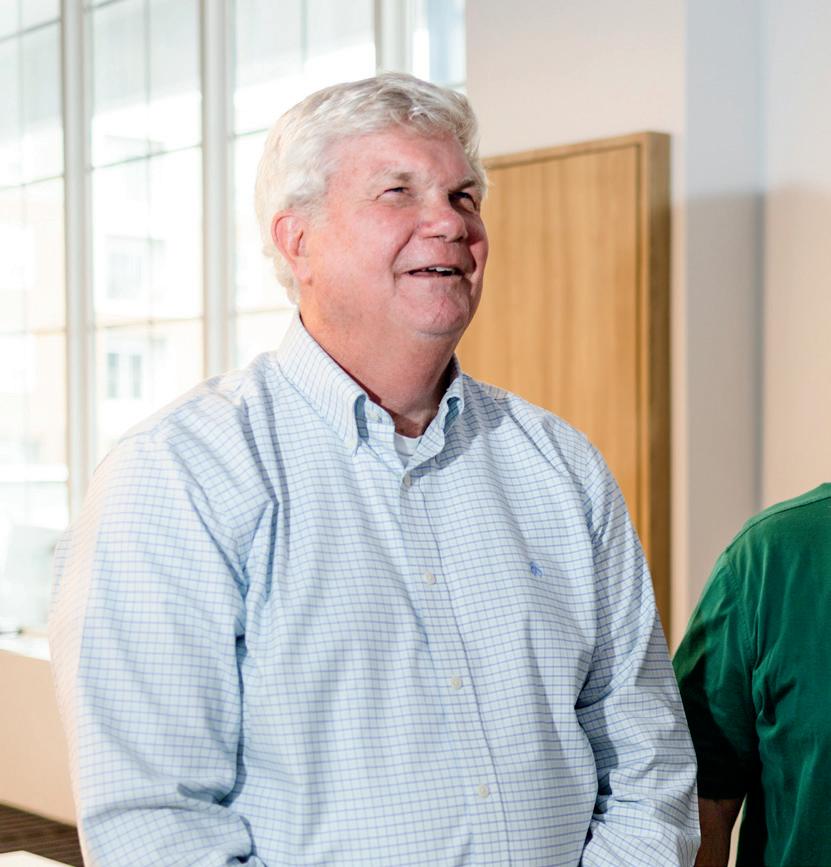
POWERS RECOGNIZED A NEED
Powers is following a course that runs parallel to that of Durham. The 1971 Benedictine graduate found himself contemplating what was next following his retirement from the world of business, where he served as vice president for Aon, an international consulting firm, by focusing on risk management and human resource strategy development over a 35-year stretch. “I still had lots of energy,” he stated. “But I had not yet figured where it could be best used.”
Powers befriended a group of nurse assistants who were caring for his mother-in-law in Georgia. Over the nine months of assistance they rendered, he realized they were lacking in some basic life skills. “They asked about banking, loans and mortgages. I realized many were dealing with payday lenders. They were not thinking about payments and financial impacts.”
34 LABORA • • •
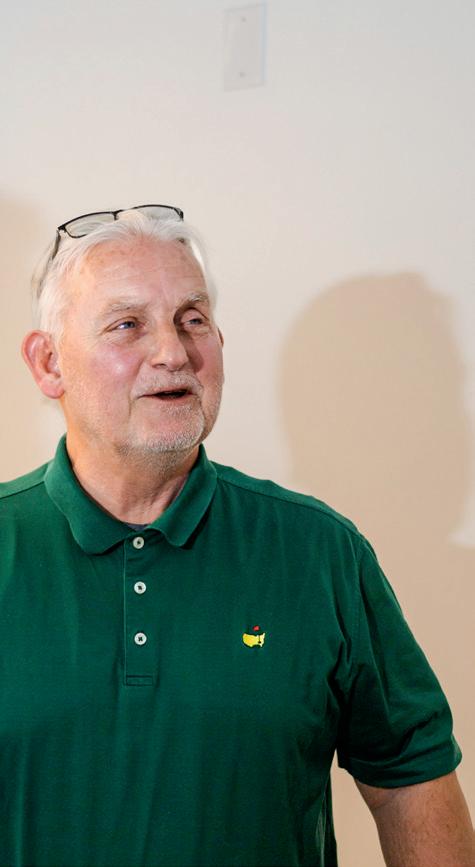
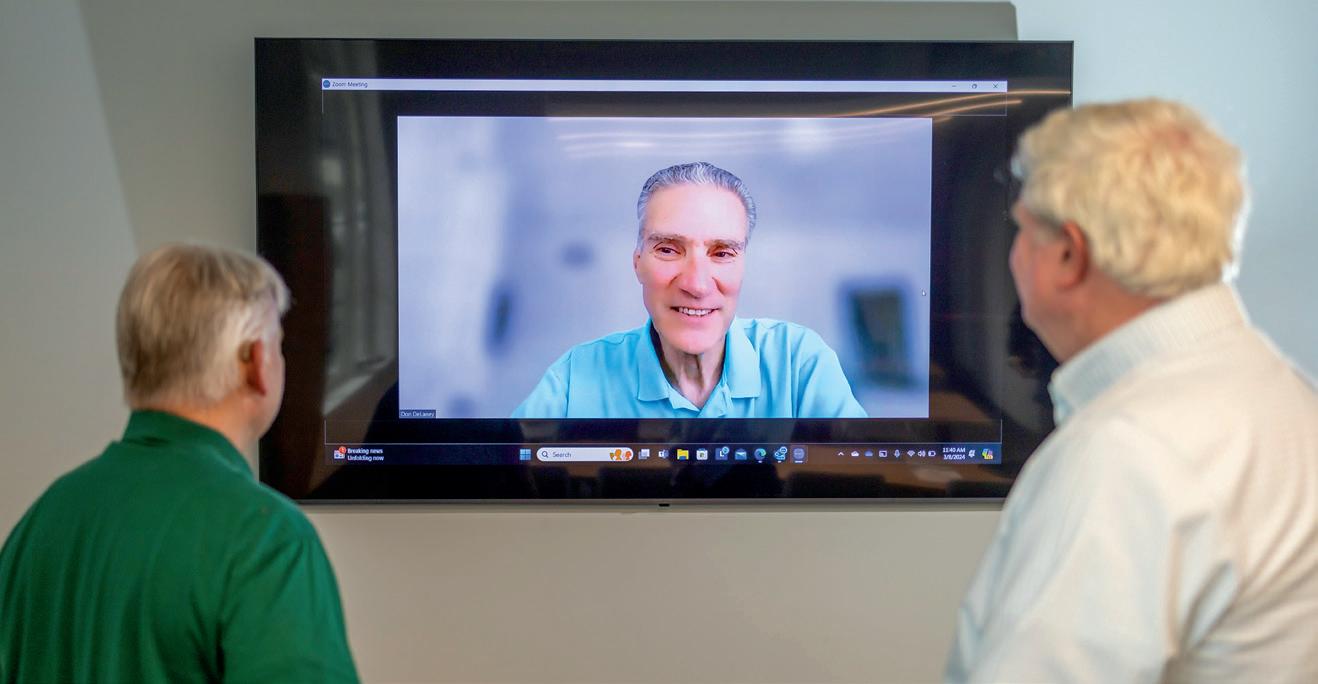
Gary Powers and Gerry White ’72, who has volunteered with TSF since 2022, meet with Don DeLaney via Zoom.
As he pondered those discussions, he came to realize that there was a need among that group for financial education. “The Lord is leading me,” Powers remembered thinking at the time. “I just wasn’t sure which population most needed my help.” With that, he began working with a nonprofit in Brunswick, Georgia, that provided financial literacy, computer skills and job-hunting tools to low-income residents. “I loved what they were doing, and the data showed its effectiveness,” said Powers. “Participants were getting a living wage and were leaving the housing projects.”
After his mother-in-law’s passing, Powers and his wife Christie returned fully to Richmond. While in Georgia, he had been sharing information with classmate (at Benedictine and at William & Mary) Don DeLaney, who was a vice president at Allen Corporation of America (a telecom) at the time. “I felt I needed to make a difference,” said DeLaney. “I’d spent lots of time on
boards but now wanted to make a real impact. I had been staying in my comfort zone.”
The two conspired to bring some type of replication of the Brunswick operational model to RVA. But before doing so, the pair did its due diligence, meeting with more than 50 local non-profits, such as Goodwill, Commonwealth Catholic Charities and Caritas.
Finally, the two struck gold in two meetings with foster care advocates: Janet Vestal Kelly, founder of Virginia Kids Belong (and a former Secretary of the Commonwealth) and Jason Brown, the leader of Fostering Acadia, with its “Independent Living” program. It was Kelly who pointed Powers and DeLaney in Brown’s direction.
TAKING THE NEXT STEP
Thus, was born The Success Foundation of Virginia (TSF). This organization utilizes a structured, and somewhat analytical, approach. TSF kicks off the process with individual meetings with the young adults it potentially serves. These sessions are designed to ascertain their strengths and backgrounds (including work and educational experience), their goals and their ambitions. TSF also administers a battery of assessments designed to identify an individual’s knowledge, skills and abilities with an eye toward introducing clients to new opportunities. An additional goal is to establish a forward-thinking bond. “Our goal is to help them think about what they are good at,” stated Powers. “We constantly encourage them to think about career paths they never thought possible — to realize they have the potential to accomplish something special in their lives that they never dreamed was possible.”
— GUIDING CHANGE — • • • LABORA 35
Among Virginia youth who have aged out of foster care, only 60 percent of 19-year-olds had earned a high school diploma or GED (General Educational Development credential).
U.S. DEPARTMENT OF HEALTH AND HUMAN SERVICES CHILDREN’S BUREAU.
Through goal setting (including those that strive to reach stability and improvement in education, employment, financial knowledge and transportation) and monitoring of progress against those goals, TSF strives to get these young adults ready to assume the mantle of adulthood in this modern world.
When Powers and DeLaney first started working with Fostering Acadia, Brown and his people were working with 15 foster children. Today, that number stands at 70. TSF was working with many of those (and continues to do so), but “after a year, we realized that we needed to start mentoring them at least two years before transitioning out at 21,” remembered Powers. “We also needed a dedicated case manager.”
That case manager emerged in the form of Brent Rolsten, a retired Ohio pastor. “TSF has been extremely blessed to have Brent walk along our side on our journey,” said Powers, who also noted the gratitude he has for Brown’s early realization of TSF’s potential, calling Brown a “real visionary.”
Powers and DeLaney also came to another realization. “We can only work with the top 10 percent of [Fostering Acadia candidates] because of the intensity of what we do (due to varying levels of academic readiness and motivation),” DeLaney recalled. “We had to assess in order to ascertain the possibilities for them.”

That intensity is certainly needed. “Non-foster peers are so far ahead, and not even they are ready to be on their own,” noted Brown. “We have to get our guys ahead of their non-foster peers. There is no back-up option.”
TSF has also supported the efforts of Commonwealth Catholic Charities and that organization’s focus on aiding unaccompanied refugee minors. “It is the work of the Holy Spirit,” assessed Powers, noting that those from that group “come to the United States with an attitude that is energized — that they are ecstatic to be here,” but they face many obstacles to integration.
Powers has several takeaways from his time working in the world of foster care. “What I did professionally prepared me for this role,” he declared. “This is the Holy Spirit’s goal for me. Thirty-five years of consulting prepared me.” Powers noted that while he and DeLaney are driven by their faith, TSF is a secular organization that is welcoming to all.
“I also realized that the state of Virginia is spending a ton of money,” noted Powers. “But there is no accountability of the impact. We have to track data to show that impact. At the same time, we’re trying to tear down silos and work collaboratively.”
“Gary and I take pride in getting a lot of blank stares when we ask about outcome-based analytics,” explained DeLaney. “They’re just not being captured.”
TOUGH SLEDDING
The issues that Durham and Powers are taking on are real, they are persistent and they are painful.
The Department of Housing and Urban Development offers a program that issues Section 8 housing vouchers to former foster children, up to the age of 24. But the program is fraught with bureaucratic requirements, including one that mandates public housing agencies, public child welfare agencies and non-governmental organizations work together to determine the eligibility of those who have transitioned from foster care. Additionally, there needs to be a caseworker, something many former fosters lack, especially those over the age of 21, since casework support ends at that point.
36 LABORA • • •
While getting a roof over their heads and food in their fridges is certainly critical, those in transition have some major, though intangible, needs, such as socialization, companionship, direction and life skills. Many have yet to overcome traumatic events they had experienced along the way. Some never will.
Education, or lack thereof, is another hindrance to those transitioning into adulthood from foster care. In Virginia, the Department of Social Services manages the Foster My Future program, which offers housing assistance, as well as funding for college tuition and living expenses. Again, the requirements are onerous. Many foster children lack the guidance to successfully navigate the forms and requirements needed to get into college in the first place, a dynamic that is mirrored in the low college completion numbers for former foster children.

Among Virginia youth who have aged out of foster care, only 60 percent of 19-year-olds had earned a high school diploma or GED (General Educational Development credential), according to the latest follow up by the U.S. Department of Health and Human Services Children’s Bureau.
“I’ve put all my blood, sweat, tears and savings account into getting this done,” said Durham. “One of my biggest shocks was seeing how the world is. It’s not pretty.”
Durham described an especially troubling story of a young woman who, as a 15-year-old living in Texas, was grabbed and sold to a man in Maryland. She managed to escape and steal a car, driving it to Virginia. Apprehended, the girl was placed in a mental institution. “She is very sweet,” noted Durham, who has worked to help stabilize her life. “But she has been traumatized.”
Noted Durham, “These are kids who don’t have a warm story.”
But the driving goal behind organizations such as Fostering Hope RVA and The Success Foundation is to give those same kids a better story. It takes people like Durham and Powers and DeLaney and others yet to come to make that happen.
“I want to pursue a sense of normalcy for them. I want them to understand we’re not caseworkers. That I have a story very similar to theirs. They open up to relatability.”
CHRISTI DURHAM
Gary Powers (on left) with TSF mentors (left to right): Rocky Rochester, Donna Shires, Gerry White, Larry Land and Gordy Rawles, M.D.
— GUIDING CHANGE — • • • LABORA 37
Brothers in Arms
LIFELONG FRIENDS ARE FOUNDERS
OF THE SUCCESS FOUNDATION
Gary Powers and Don DeLaney go back a bit. In fact, the two go back to the days before the following took place:
The first landing on the moon
The breakup of the Beatles
The introduction of the Post-It Note, the Rubik’s Cube and unleaded gasoline
The presidency of Richard Nixon
The two became friends during their first year at Benedictine, starting in the fall of 1967. After graduating from Benedictine, both enrolled at William & Mary. They have remained close friends during the half century that followed.
So, it was logical that Powers would turn to DeLaney when looking to create a difference-making start-up. That was the first time he would lean into his Rolodex. It was hardly the last.
One of the major drivers that both men point to is Gary’s middle brother Chris Powers ’69. “He was a role model for us,” asserted DeLaney. “He was committed to social ministries, including providing mentoring to newly released younger convicts. He was making a difference.”
Chris died suddenly at the age of 65. “That made us start looking at things differently,” said DeLaney.
The pair brought in another Benedictine contact, Gerry White ’72, who provided some legal administration and advice when The Success Foundation (TSF) was being formed. Gradually, White was pulled into the world of that organization, soon finding himself filling the role of mentor to fosters who were transitioning to adult status.
“Don and Gary have persistence, energy and vision that are amazing,” assessed White. “They have huge hearts that want to contribute. It’s not something a lot of people do in retirement.”
White also pointed to the great amount of energy that the two put toward recruiting, whether it be for guest speakers or for new mentors.

Don DeLaney and Gary Powers, Benedictine classmates and partners in supporting young people in need.
DIVIDE AND CONQUER
Powers manages the relationship with Richmond’s Fostering Acadia, while DeLaney works with Commonwealth Catholic Charities. In providing mentoring assistance to mentees of those two organizations, the pair puts together teams — a primary and a secondary mentor per individual. “My role is to put teams together,” said Powers.
He also recruits to his cause and, by many accounts, is constantly doing so. Neighbors, friends, former classmates, former business associates and casual acquaintances are all fair game. “I like recruiting younger mentors,” Powers said. “But most of our volunteers are retirees and people I’ve known from my walk through life. They are the ones who ultimately deserve all of the credit for our great success.”
“I’d heard Gary had started The Success Foundation. I looked it up, and it sounded really neat,” recalled Sara Hillgrove, who works as a mentor for TSF. “I sent Gary an email. Once you do that, Gary’s got you. He dragged me right in, but I didn’t need dragging.”
“We are kindred in our drive and in the knowledge that we’ve had blessed lives and can give back. We see struggles but know they are not insurmountable.”
LISA
POWERS ROCK TSF VOLUNTEER
38 LABORA • • •
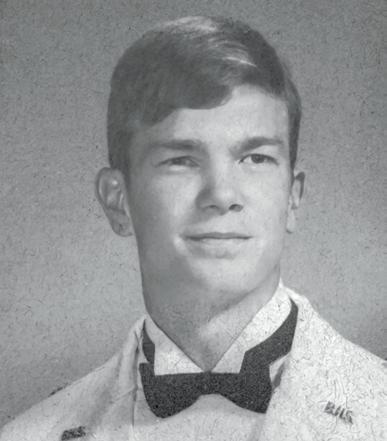

Powers has even recruited family members, as his sister Lisa Powers Rock ’76 will attest. She has been brought into the fold and helps fill a number of gaps with TSF, even while living in Jacksonville, Florida. “We have such a great team,” she enthused. “We are kindred in our drive and in the knowledge that we’ve had blessed lives and can give back. We see struggles but know they are not insurmountable.”
Powers shared the story of a 21-year-old El Salvador native who had arrived in the U.S. as an unaccompanied 12-year-old girl and who was a candidate for TSF. Concurrently, TSF staff learned of a 28-year-old woman (named Steffay) with an identical set of circumstances, but who was thriving in adulthood and wanted to give back. Following due diligence, Steffay joined the team as a mentor. Powers was present when the two women met. “It was pure magic,” Powers recalled. “The mentee started crying, saying she’d finally met her big sister.”
“I could tell 100 stories of doors like this that have opened to us over the past five years,” said Powers. “None of which were the least bit coincidental.”
Powers and DeLaney are quick to acknowledge some critical generosity that TSF has received, including from someone with a school connection. “Joe Conte (BHS/SGHS parent) and the Ralph D. Conte Foundation have been so generous in their support of our efforts,” said Powers.
Added DeLaney, “There is no way TSF would have experienced the success we have had over the past five years without Joe’s great support.”
The success is also due to the significant efforts of Powers and DeLaney. “They really go all-in on what they’re doing,” said Hillgrove. “They will run through a brick wall for these young adults.”
“It’s very satisfying, but there is no one size fits all for these kids ...”
DON DELANEY
“It’s very satisfying, but there is no one size fits all for these kids,” explained DeLaney. “It’s all about building trust and relationships. Being there for them is critical. It takes a long time for them to trust you’ll be there.”
Perhaps TSF’s biggest fan is Jason Brown, founder of Fostering Acadia, a foster non-profit that identifies clients of its program for possible mentorship from TSF. Brown and his wife have worked in foster care for nearly two decades. “We don’t often see people from the community raise a hand to help,” he said. “I’ve never seen such a thing. This is once-in-a-lifetime to see them willing to serve and help.”
EXTRA SAUCE
A side benefit came from all the research that Powers and DeLaney did in honing their non-profit role. They met with leaders of over 50 non-profit organizations in the greater Richmond area before they landed upon a mission for TSF. They also conducted research on those organizations. Rather than letting that information stagnate while they focused on building out their new non-profit, they organized that work into what became the RVA Community Resource Book (CRB).
It is a well-organized reference book that provides detailed information, including contacts, missions, goals, objectives and service offerings about area non-profits involved in job training and workforce development, alternative schools for low-income families, adoption and placement of children and young adults, homeless support and more. It is a handy reference for those seeking volunteer opportunities or for those looking for assistance.
When they founded TSF in October 2018, Powers and DeLaney made up the entire organization. They have since grown their organization to the point that it has 33 mentors serving Foster Acadia and Commonwealth Catholic Charities. And the two are more than happy to bring on more mentors.
Don DeLaney
Gary Powers
— GUIDING CHANGE — • • • LABORA 39

Myths About Foster Care
For most of us, the idea of foster care is fairly abstract. We may know of foster children, but we may not actually know any. We may have heard of the role of foster parents, but that is something other people do.
That lack of experience may lead us to develop unfounded beliefs relative to the foster care system and of those who participate — both as child and as parent — in that world.
MONEY MYTHS
A belief exists that there is significant money to be made by being a foster parent. If there truly are people who view fostering as an income-generating pursuit, they should know that there are a substantial number of jobs paying a vastly higher income than what is earned via the foster route. For instance, foster parents in Virginia receive a monthly stipend from the state, which is expected to cover some of the costs associated with caring for a child (or children) in the home. The rates range from $486 per month for children up to four years of age to $721 for children over the age of 13 years.
If a child were to spend her entire life in foster care, the state would pay stipends that total $121,116 through her entry into adulthood. That seems like a pretty hefty sum, until you learn that a study by Lending Tree shows that American families on average spend $237,482 to raise a child to the age of 18. By the way, that $121,116 works out to $6,729 per year. In Virginia, each child is allocated an annual clothing allowance of between $315 (for infants and toddlers) to $473 (for teenagers) and foster children are eligible for Medicaid regardless of the family’s financial situation. Still, nobody is getting rich on this program. “Sadly, a lot of people think there is money in the foster program,” noted Christi Durham.
BEHAVIORAL MYTHS
Some may be hesitant to take on the role of foster parent because of perceptions that foster children are “problematic” or prone to being difficult. Yet, according to research by the Virginia Department of Social Services, difficulties that arise to the level of removing the child from the home are primarily driven by issues with the foster parent. In fact, slightly less than one-fifth (19.49 percent) of the drivers in the removal of a child are, in fact, issues with that child, with only about three percent of that smallish number stemming from abuse of drugs or alcohol.
PLACEMENT MYTHS
A third misperception is that children are placed in foster care only because of abuse or neglect. In fact, while abuse and neglect often do play a lead role, there are many other reasons for such placement:
Death of parent(s)
Abandonment
Parental addiction
Parental incarceration
Juvenile offenses
Voluntary placement
you can help FOR MORE INFORMATION AND RESOURCES GO TO:
How
FosterVA fosterva.org Fostering Acadia fosteringacadia.org Fostering Hope RVA fosteringhoperva.org The Success Foundation successva.org 40 LABORA • • •
SUITABILITY MYTHS
A final misperception, according to FosterVA, is that potential foster parents are only allowed to do so for children of their same race. This idea is patently false. According to the Virginia Department of Social Services, there are zero gender, cultural, ethnicity, marital status, educational or home ownership requirements for becoming a foster parent.
The Department of Health and Human Services Administration for Children and Families and the National Council for Adoption provide data on adoptions, both transracial and otherwise. In May of 2023, the total number of children in foster care was 367,699, and 53,621 children had been adopted that federal fiscal year. Diving deeper into those numbers paints a clearer picture of the state of adoption in the U.S.

The State of Adoption in the U.S.*
Such numbers point to the strong need for a robust foster care system. The need is especially strong for those who might step up and take on the mantle of foster parent. They also show that the work of Fostering Hope RVA, The Success Foundation and all those who work to enrich the lives of foster children is so critical. 10.3%
in foster care and 927 adopted 10.4%
CHILDREN
in foster care and 207 adopted 10.2%
CHILDREN (OF ANY RACE)
in foster care and 10,889 adopted 12.7%
HAWAIIAN CHILDREN 976 in foster care and 124 adopted 17.1% MULTIRACIAL CHILDREN
in foster care and 5,032 adopted 10.6%
UNKNOWN-RACE CHILDREN
in foster care and 797 adopted 17.4%
Virginia state foster services dss.virginia.gov/fosterVA/index.html
8,987
ASIAN
BLACK
foster
HISPANIC
79,090
AMERICAN INDIAN/ALASKA NATIVE CHILDREN
1,979
CHILDREN 83,085 in
care and 8,466 adopted 13.8%
NATIVE
29,466
WHITE
156,570
ALL
367,699
7,546
CHILDREN
in foster care and 27,179 adopted 14.6%
CHILDREN
in foster care and 53,621 adopted
— GUIDING CHANGE — *
DEPARTMENT OF HEALTH AND HUMAN SERVICES’ AFCARS REPORT, MAY 9, 2023 • • • LABORA 41
SOURCE: U.S.


42 LABORA • • •
Estate & Planned Giving Your TheirLegacy, Future
YOUR SUPPORT CAN HAVE A PROFOUND IMPACT ON THE VERY FABRIC OF OUR SCHOOLS
By incorporating planned giving into your financial strategy, you are not just donating; you are shaping the future of the Benedictine Schools of Richmond community. Your commitment to planned giving provides resources for scholarships, innovative programs, teacher development and state-of-the-art facilities.
Gifts through wills, property, life insurance, retirement plan assets and IRAs, and other methods are an investment in the financial security of our schools and help us fulfill our mission to develop young leaders of character who glorify God in all things.
EMPOWERING FUTURE GENERATIONS
You need not have a large estate to make a meaningful planned gift. Gifts of any size support our continued growth and success, and they inspire others to make similar gifts that uphold the traditions and quality of a Benedictine and Saint Gertrude education.
Learn more today about how your planned gift will provide for our students well into the future. For additional information about planned giving options that can also provide financial benefits to you and your heirs, please contact Kristina Pudner, Director of Scholarship Giving at 804-708-9581 or kpudner@benedictineschools.org


PLANNED GIVING OPTIONS
Bequest A simple bequest is the most common gift option that also reduces the size of your taxable estate. You may include in your will either a specific dollar amount or a percentage of your assets.
Life Insurance The option to name Benedictine Schools of Richmond as a beneficiary of your policy is especially helpful to younger alums who might not yet have obvious beneficiaries — but it is also another easy gift option for donors of any age.
IRAs or Retirement Plan
Assets Designating gifts of these assets can save income and estate taxes and protect your liquidity. There is a required minimum distribution once you reach the age of 73.*
Real or Personal Property
This option includes an outright gift of real estate or other personal property you fully own. You can deduct the fair market value of the property (determined by an objective appraiser) and avoid capital gains tax.
Charitable Gift Annuity
This is a simple contract between you and Benedictine Schools of Richmond that pays you a lifetime income stream from assets transferred to the charity.
Charitable Trusts — Lead, Remainder or Unitrusts
You can explore with us and your financial or legal advisor these more complex options that could provide you with greater tax benefits.
Consult your financial advisor or attorney before making a planned gift.
— ENDOWMENT GIVING —
*DUE TO THE UNIQUE CORPORATE STRUCTURE OF BENEDICTINE SCHOOLS EDUCATIONAL FOUNDATION, QUALIFIED CHARITABLE DISTRIBUTIONS SHOULD BE UNRESTRICTED GIFTS TO BENEDICTINE SCHOOLS OF RICHMOND. • • • LABORA 43

44 LABORA • • •
Igniting Innovation BSoR Launches Entrepreneurial Studies Program
— DEL SMITH ’01, BENEDICTINE HEAD OF SCHOOL —
Over the past two years, in addition to my administrative duties at Benedictine, I have taught a course called “Business Accounting and Finance.” It is something that I saw (and continue to see) as a means of helping our students understand how the world works, from a dollars and cents perspective.

While the focus of our schools is college preparation, we are also readying our charges for the bigger game of life. Courses such as AP Macroeconomics and our leadership curriculum are joined by the Business Accounting and Finance course in providing some common-sense vantages of how things work in the real world.
In the course, we dive deeply into areas such as stocks and bonds, home buying and financing, banking, good savings habits, household budgeting and the tax code. This year, 52 BCP students (all are juniors or seniors and are spread over multiple sections) enrolled in the course. To date, over 100 students have taken it. Throughout, I have flat-out loved the level of interest and engagement displayed by the Cadets.
Word spread quickly to the other side of the campus, and we recognized a demand for the same content at Saint Gertrude. This year, Mike Gill introduced the course to the SGHS students, and the Gators have welcomed that training quite warmly. With a class of 17 students, Mike has used an approach that closely mirrors that which is used at Benedictine, and he will continue to run with it at SGHS into the future.
Next fall, the course at both schools will be enhanced to embrace the spirit of the Labora magazine. Each will be changed to dedicate a full academic year quarter to entrepreneurial studies. The curriculum is under development now and those courses will include topics such as venture capital, product and business
development, talent searches, market evaluation, logistics planning, cost/benefit analysis, SWOT analysis and more.
During this initial year of the expanded program, we will be gauging students’ responses to the courses and determining if we will also develop an entrepreneurial course as a stand-alone offering in the future. Introducing entrepreneurship as part of the business curriculum allows us to identify where a future elective might fit toward a student’s graduation.
You might be surprised at some of the entrepreneurial efforts our students have undertaken. Among our ranks you will find young men and women who have started up summer businesses or after-school efforts (or both). Examples include a perfume and candle manufacturer, a dog trainer, a yard-service provider and a lunch provider. We will likely bake some of those experiences, as well as those of adult entrepreneurs, into the curriculum.
NEW SCHOLARSHIP TO SUPPORT STUDENTS
Lastly, it gives me great pleasure to announce the new Joseph and Gene Swedish Family Foundation Entrepreneurial Scholarship. Joe ’69 has been a trailblazer in the field of healthcare, having retired as chairman and CEO of a Fortune 40 company. Even in retirement, he is extraordinarily active in his efforts to initiate and incubate healthcare solutions. The scholarship he and Gene are initiating will challenge and reward aspiring entrepreneurs from both Benedictine and Saint Gertrude who participate in the entrepreneurship curriculum and associated work program. Details about the new scholarship will be available soon.
I am excited and energized by the prospect that our new entrepreneurial studies program could ignite a passion in some of our students that may one day lead to the next transformative business innovation. Please stay tuned.
— EDUCATION —
Saint Gertrude teacher Mike Gill.

We are always on the lookout for great stories about entrepreneurs, innovators and inspiring leaders. If you know of a Benedictine or Saint Gertrude alum who is making a mark in the world of business, let us know. Call us at 804-708-9500 or email marketing@benedictineschools.org Stay connected! Find information about upcoming Alumni events and more 12829 River Road, Richmond, Virginia 23238 Give Us A Shout!


 JOURNAL OF ENTREP RENEURSHIP
JOURNAL OF ENTREP RENEURSHIP



















































